Aegean Art Time Period Time Period of Aegean Art
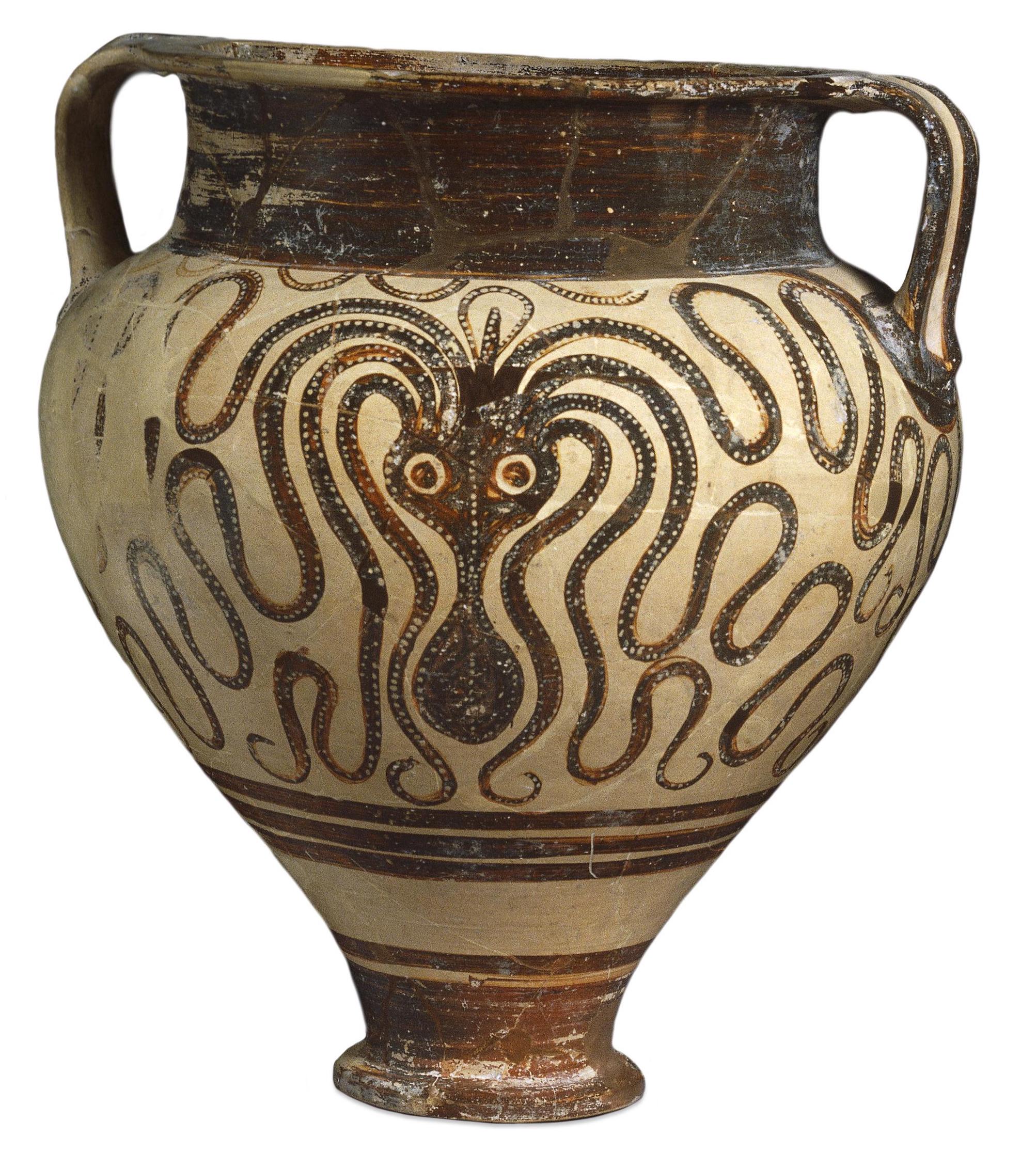
Pictorial Style bowl (krater), Mycenaean, c. 1375 B.C.Due east., 41 cm high (The British Museum)
The epic stories of the Iliad and Odyssey present the decade-long state of war betwixt mythical Greeks and Trojans and its messy aftermath. The war is ignited by the kidnapping of the Greek queen Helen by the Trojan prince Paris. The conflict is so cruelly manipulated by the Olympian gods who each selfishly have a side. Smashing kings from both lands (Agamemnon, Odysseus, Nestor and Priam, among others) battle ferociously with their kinsmen before the walls of the urban center of Troy until, through the trickery of a dandy hollow wooden equus caballus, the Greeks are able to breach the metropolis gates and slaughter or enslave the population of the city. All the Greek heroes render home laden with treasure, except Odysseus, who is tormented by vengeful Poseidon, God of the sea and supporter of the Trojans, and prevented from reaching his home for some other decade.
Were the kingdoms and characters of the mythic past described in the Iliad and the Odyssey real? The study of the fine art of the Statuary Historic period Aegean (engagement range) developed out of attempts to respond this very question. It is estimated that the epic poems of the Iliad and Odyssey were start written down in the 8 th century B.C.E. by Homer simply they were composed much earlier and passed on orally. Despite the poems' long lived popularity, from aboriginal Greece down to our own era, key facts about the original version(south) of Homer's works, when they were composed, where, by whom, and if they are based on any real events and/or people are largely unknown. What nosotros do know is that those who preceded the people of the Greek Iron Age (1100–800 B.C.E.), who were the inspiration for the epics, were the cultures of the Statuary Historic period.
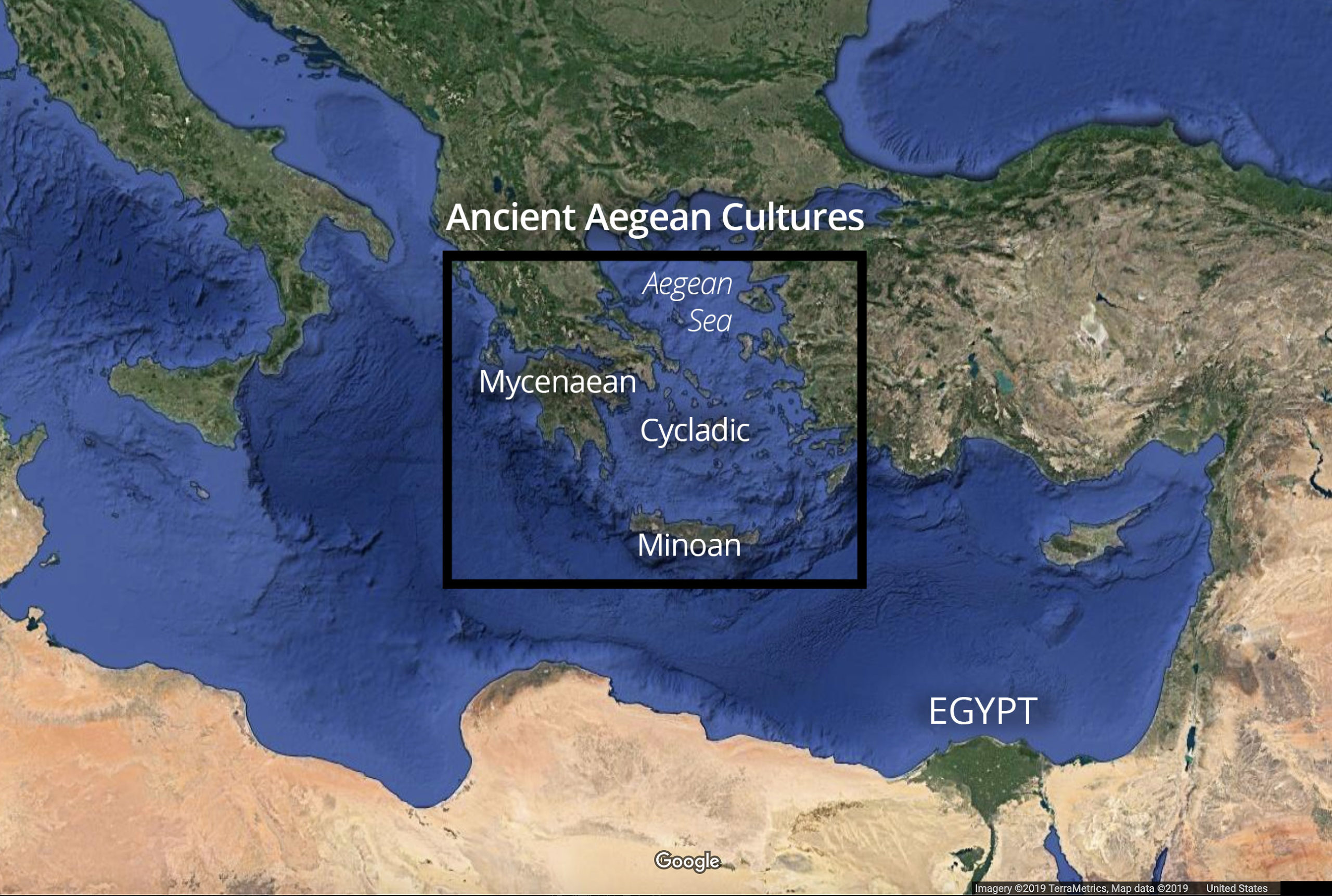
Map showing ancient Aegean cultures (underlying map © Google)
The cultures of the Bronze Historic period Aegean (in the 3rd and 2nd millennium) are known every bit
- Cycladic (on the islands of the Cyclades in the Aegean Bounding main)
- Minoan (on the island of Crete)
- Mycenaean (on the Mainland of Greece).
These iii groups are traditionally treated by art historians separately and this is because of the history of the report of these regions and groups. In fact, while the people who lived on the Cycladic islands, Crete, and the Greek mainland each had unique visual traditions, they were likewise in very close contact and their visual traditions influenced each other, sometimes extensively. This affiliate takes a more thematic approach, highlighting these influences and attempting to take a pan-Aegean view.
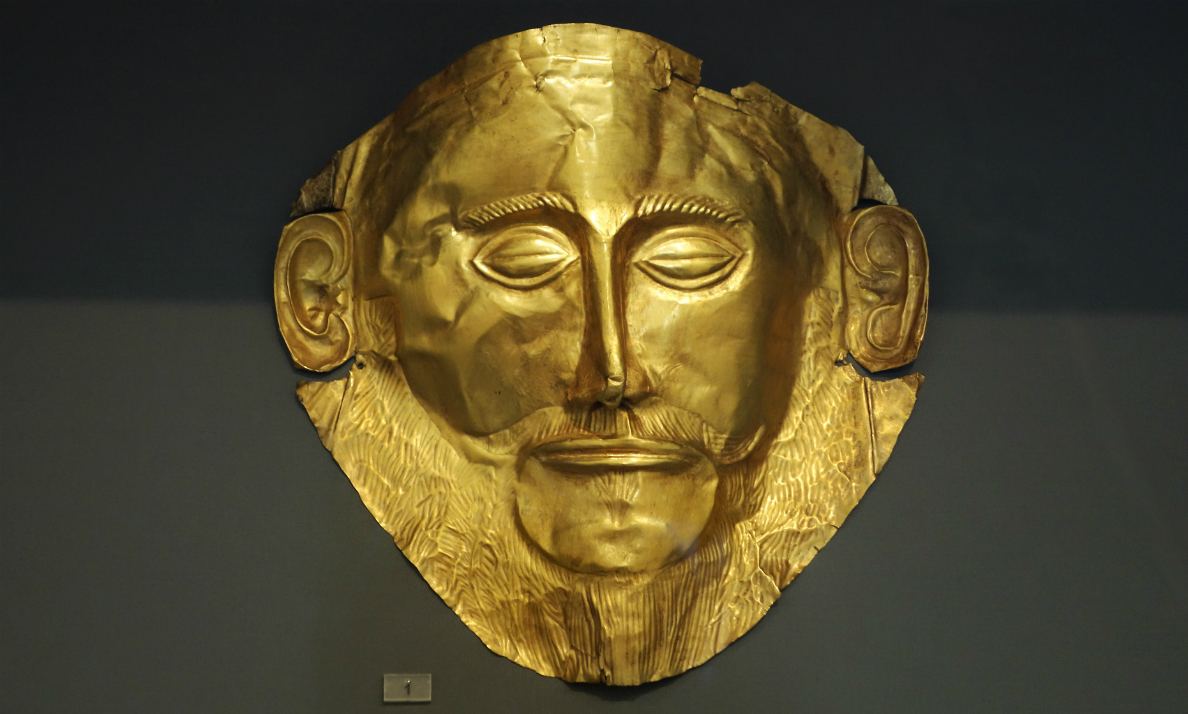
Mask of Agamemnon, c.1550–1500 B.C.E., Myceanaean, golden, establish in grave shaft V, Grave Circumvolve A in 1876 at Mycenae past Heinrich Schliemann
When we expect at Aegean art, sometimes we come across it through a Homeric lens—citadels, palaces, rich tombs and gold, a world of elite men, and mythological drama. Other times we run into cultures that produced sophisticated sculpture and pottery, with elaborate theocratic economic systems, vast networks to excerpt raw materials, and enslaved people to produce valuable merchandise goods—all similar to the next Near Eastern or Egyptian cultures of this time simply different from the world we meet in Homer. Both visions cannot be true at the same time, and Aegean scholars struggle to consolidate a coherent interpretation of all the available prove.

Reconstructed Minoan Fresco from Avaris, Egypt. At present Archaeological Museum Iraklion, Crete, Hellenic republic (photograph: Martin Dürrschnabel, CC-By-SA-2.five)
With or without Homer, the way we have looked at Aegean art has been stubbornly focused on the elite—be it elite economic and political leaders or Homeric heroes. In this chapter, women and non-elite people are discussed in the context of Aegean Fine art, revealing that if you look from a different angle, this important role of the story can not only be found in Aegean art only as well turns out to be central to Bronze Age Aegean production and consumption. Lastly, focusing on unlike aspects of elite architectural centers (Minoan palaces and Mycenaean citadels) nosotros tin see them as places of participatory ritual, populated by not-aristocracy and far more than only buildings where kings were enthroned.
Read essays about Aegean cultures
/3 Completed
Women
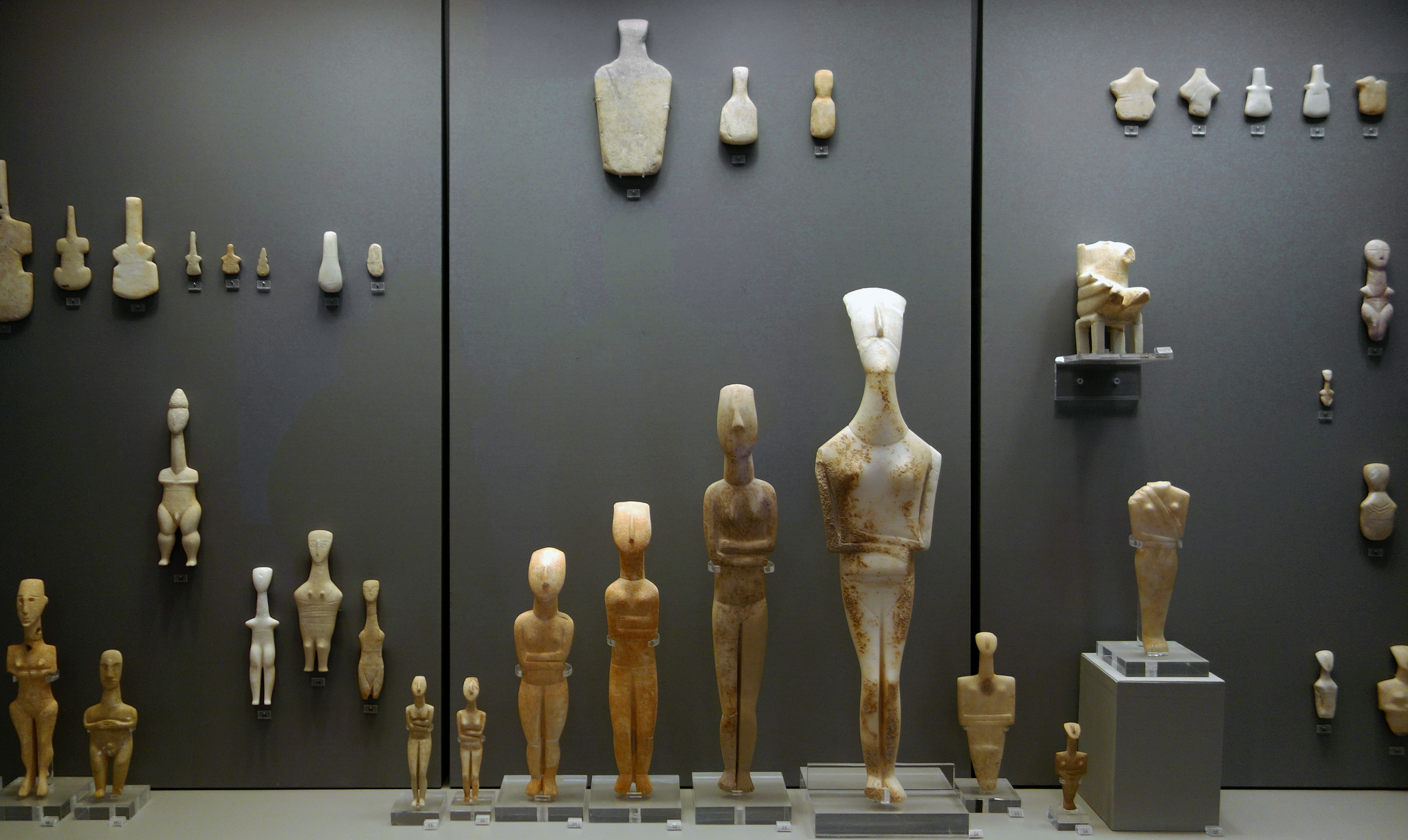
Cycladic period figures, marble (National Archaeological Museum, Athens)
At the kickoff of the Bronze Age (c. 3200 B.C.E.), the art made on the islands of the Cyclades was both unique and vastly more sophisticated than annihilation found on the Mainland of Greece or Crete. Elegant figurines and frail vessels were made from sparkling white island marble. Best known and admired of this art are the figurines, and in this tradition the representation of women is crucially of import. The overwhelming majority of Cycladic figurines represent women—nude, posed with their arms folded, toes pointed, facing ahead, rendered in a radically abstracted mode. Despite the proliferation of female person sculptures, a disproportionate amount of attending has been paid to the very few male examples of the type (presumably considering they are oftentimes represented sitting or engaged in action).

Male harp player from Keros, c. 2600–2300 B.C.E., Early on Cycladic period, marble, 22.5 cm high (National Archaeological Museum, Athens)
Information technology is a remarkable fact that at that place has been so piddling discussion well-nigh the nearly all-female aspect of Cycladic sculpture. Admittedly, because of looting in response to the very high market value of Cycladic figurines, they are frustratingly without archaeological context. Despite this, however, it is rather clear that women—mortal or otherwise—were held in loftier esteem at the time.
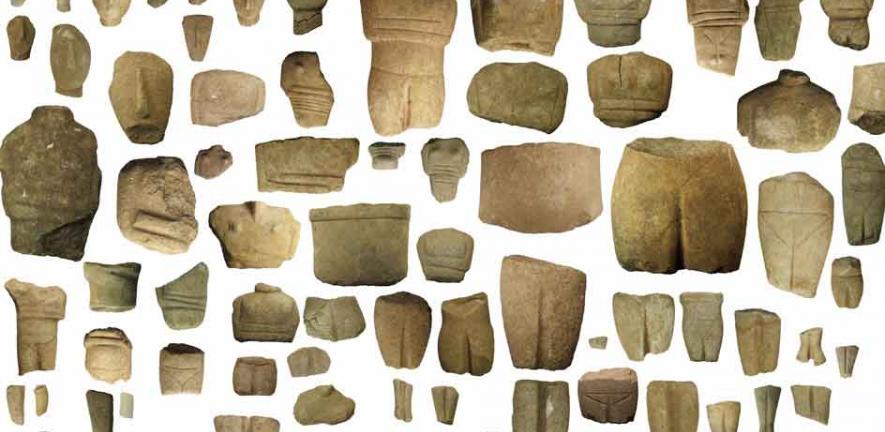
Broken figurines found during archaeological excavations on the island of Keros, Cycladic (Island of Cleaved Figurines)
Recent inquiry on a subset of these female person Cycladic figurines, those which are quite large (over 70cm high), argues that they were used in public veneration and processions, peradventure associated with the earliest regional political network in the Aegean, a confederacy centered on the island of Keros. If this is the case, we see the sculptural representation of women in the Early Statuary Historic period as powerful political and social symbols, with no known male sculptural competitors.
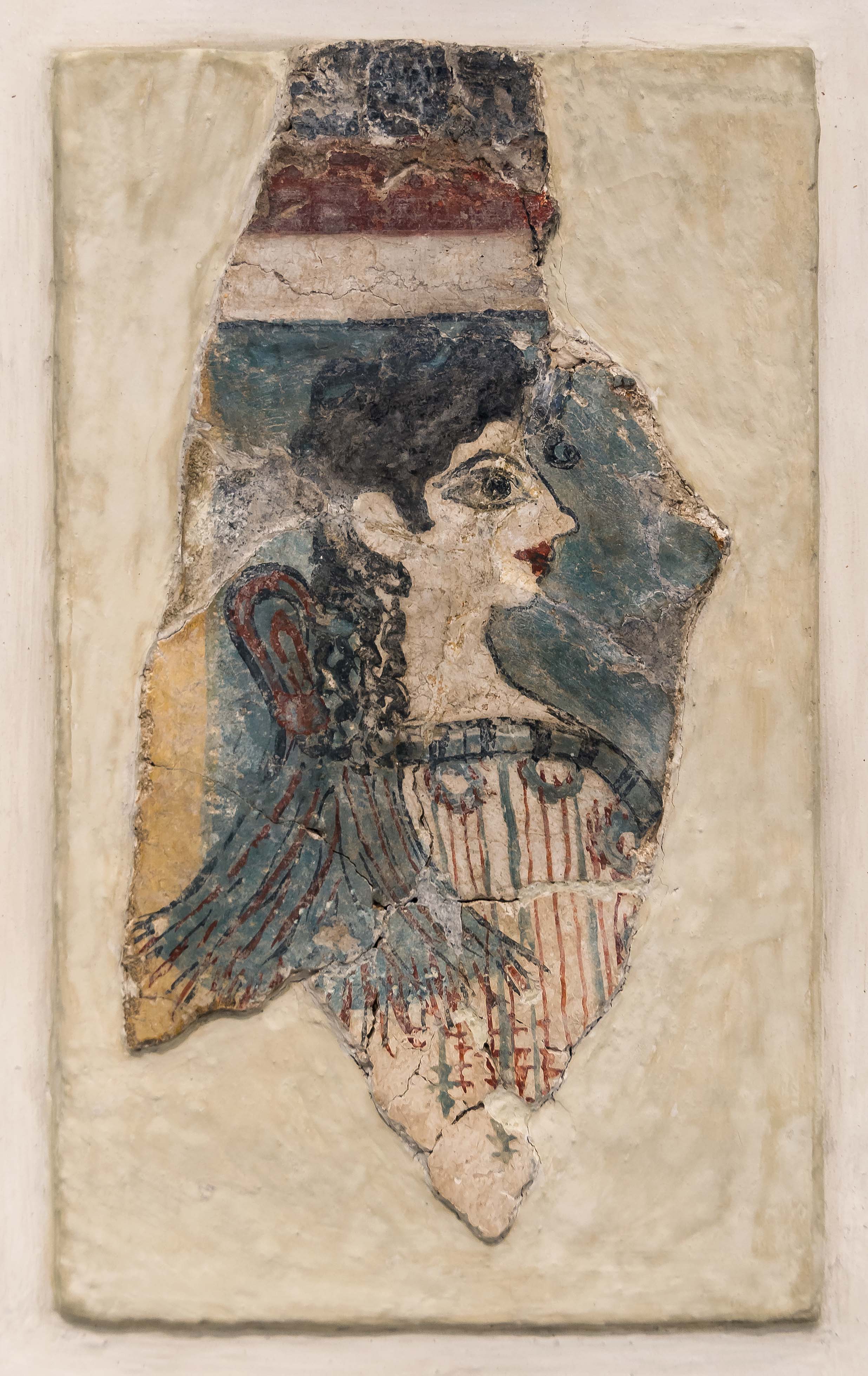
Woman or goddess ("La Parisienne") from the Camp-Stool fresco, western wing of the palace at Knossos, Minoan, buon fresco, 20 cm high (Archaeological Museum of Heraklion)
Images of women proliferate again hundreds of years later on the island of Crete among the Minoans, as well as on the Greek Mainland amid the Mycenaeans. Like their male counterparts they are represented with little variation, nigh always immature, dark haired, with a tiny waist, large hips, exposed breasts, and dressed in a variety of long rich and colorful garments. In wall painting, they are central actors and oftentimes focal points in complex narratives (though we don't know what the stories are!).
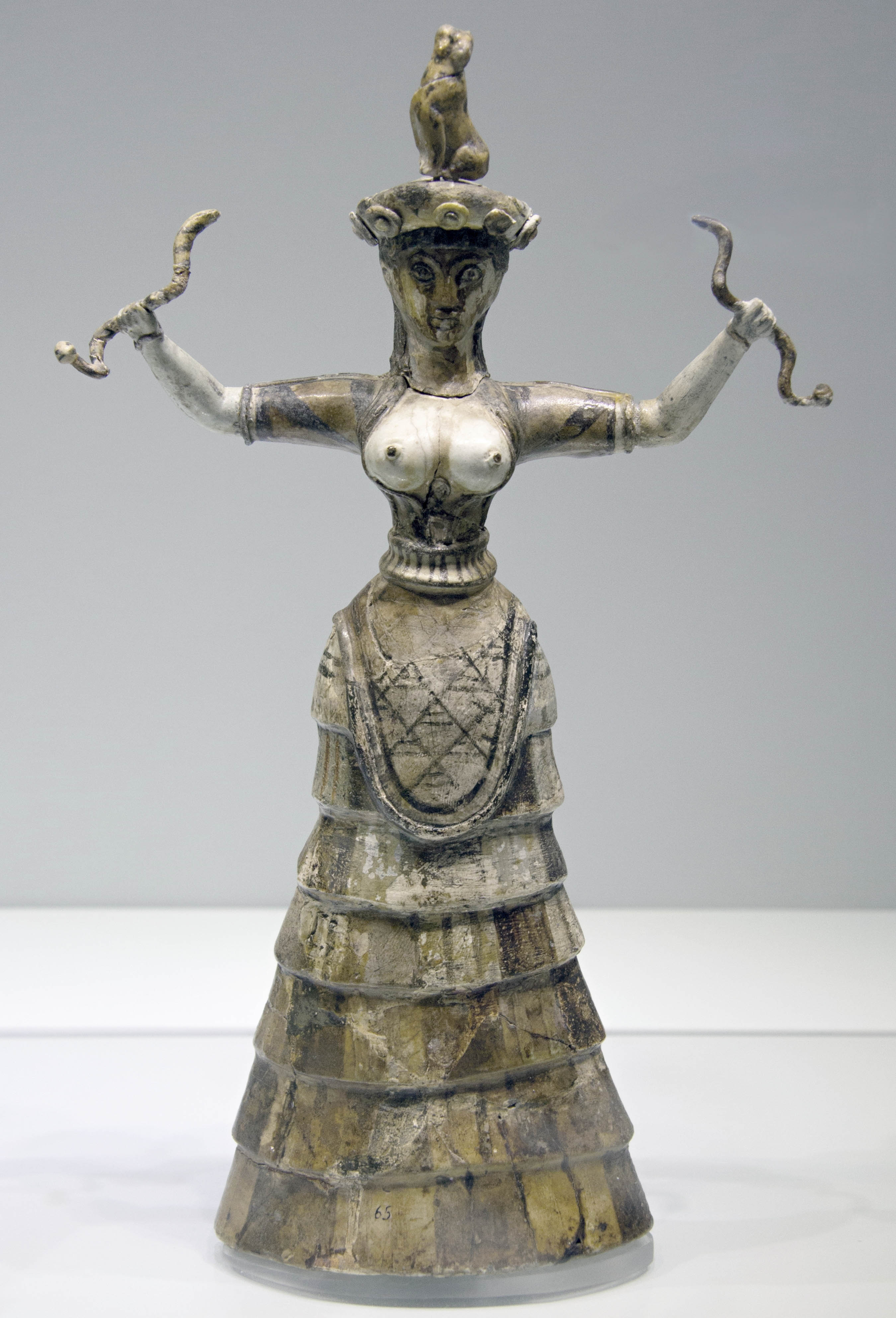
Snake Goddess from the palace at Knossos, c. 1600 B.C.E., Minoan, faience, 29.5 cm high (Archaeological Museum of Heraklion; photo: Zde, CC BY-SA four.0)
In sculpture, they strike dramatic and authoritative poses, toasting, with artillery raised or belongings their breasts.
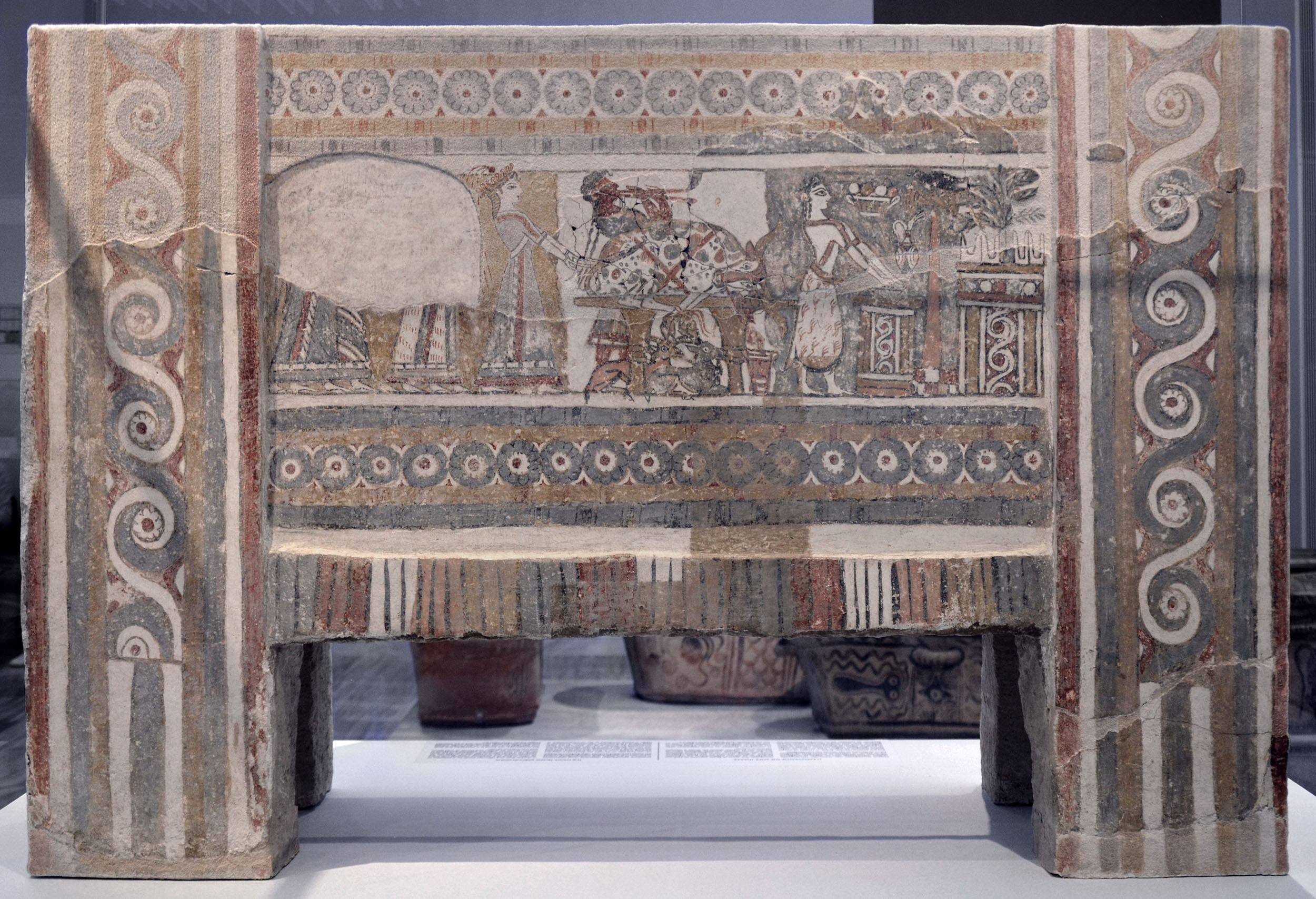
Hagia Triada sarcophagus, c. 1400 B.C.Eastward., Minoan, limestone and fresco, one.37 m long (Archaeological Museum of Heraklion)
Unquestionably, these are important women, probable mythic or religious characters, goddesses or their attendants busy with ritual. This seems especially clear on the Hagia Triada sarcophagus, a large painted coffin featuring many women in ritual procession and carrying out sacrifices.
Read essays and watch a video about women in the ancient Aegean

Male Harp Role player from Keros: Why have sculptures like this ane received more than attending than those showing women?
Read Now
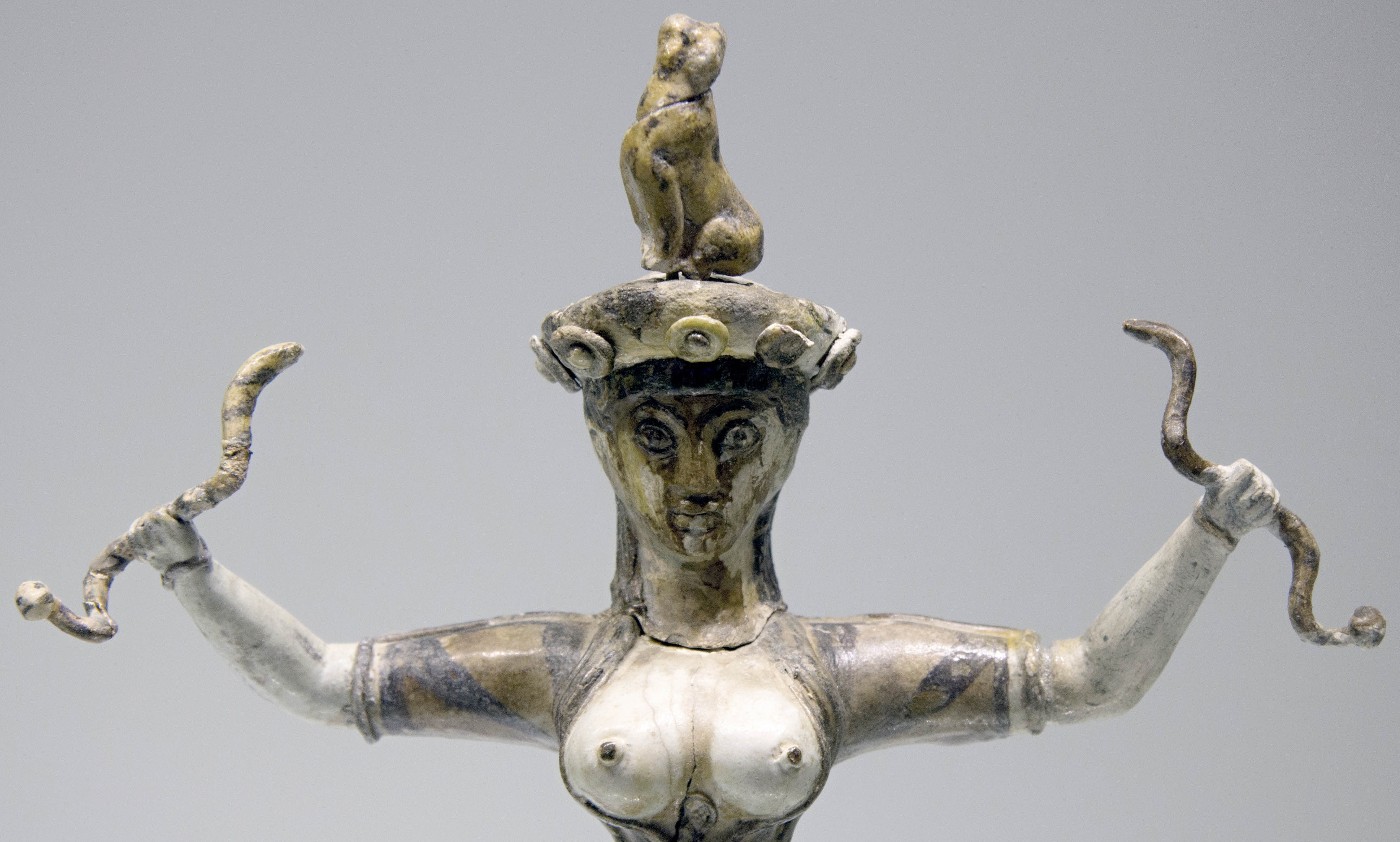
Serpent Goddess: Who does this figurine evidence?
Read At present
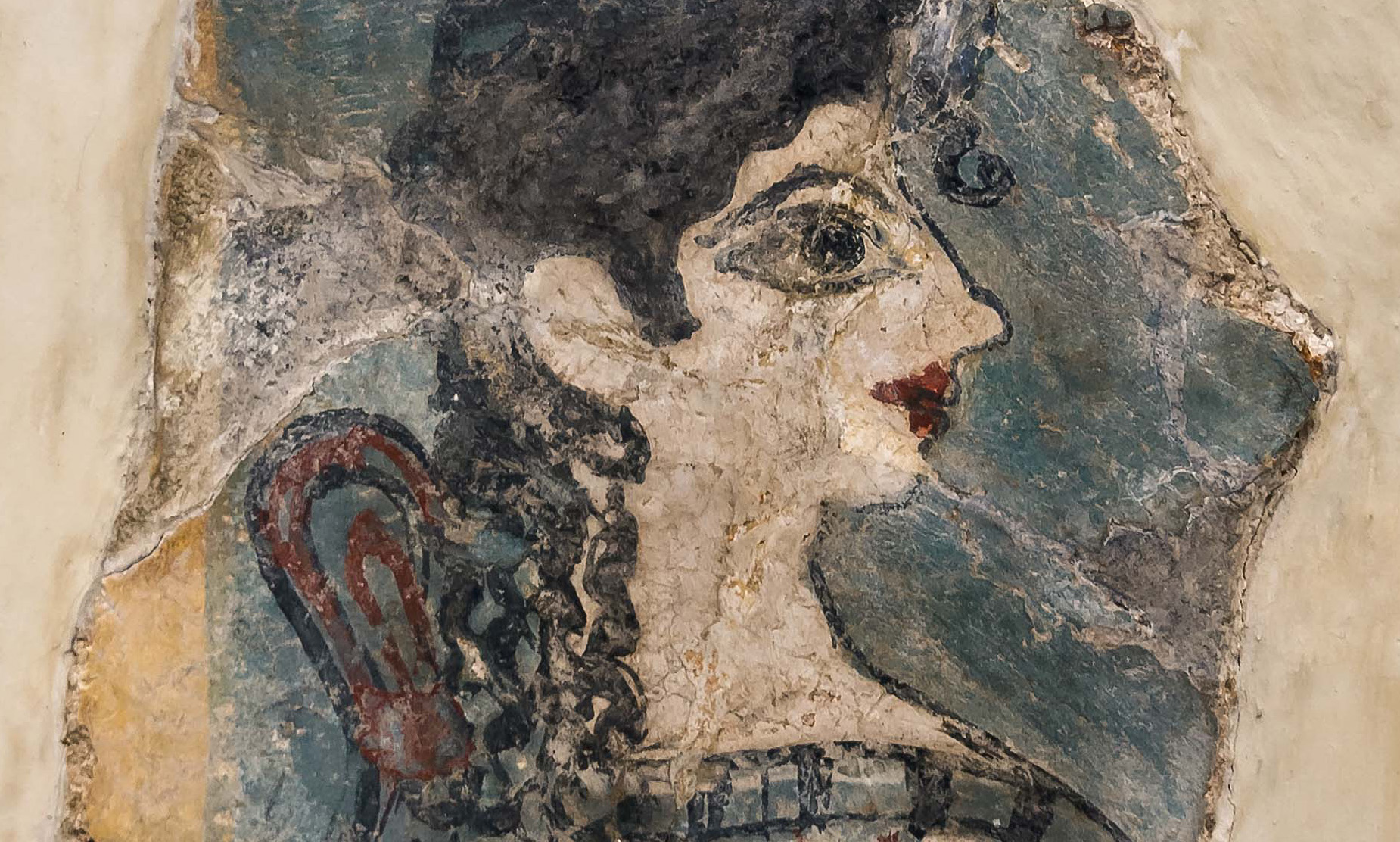
"La Parisienne": A Minoan woman or goddess from the palace of Knossos
Read At present
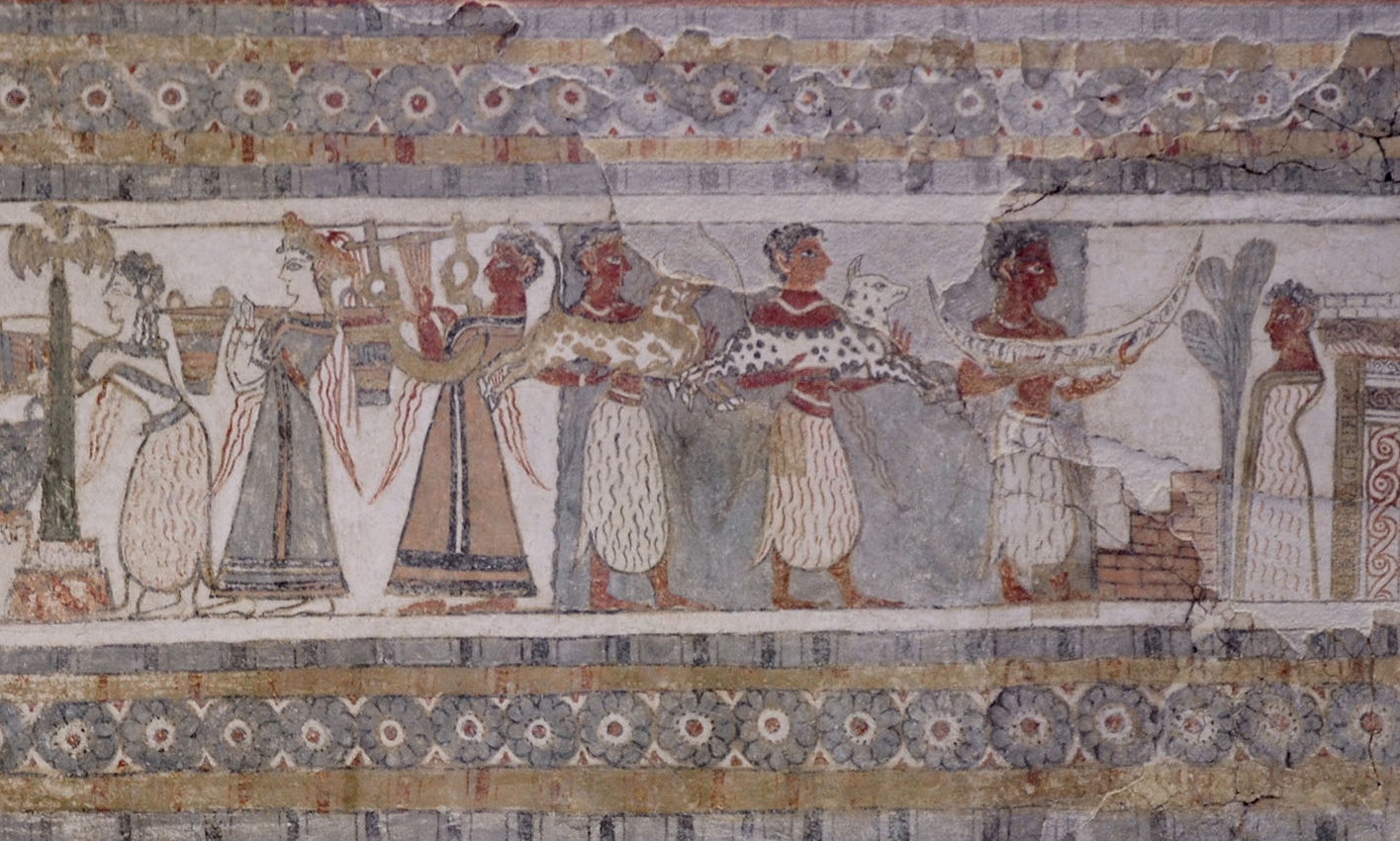
Hagia Triada sarcophagus: The but Minoan sarcophagus known to be entirely painted and showing a complex narrative scene, evidently of burying and sacrifice.
Read Now
/four Completed
What the primary sources tell united states of america nearly women
What can the cardinal role for women in the art of the Aegean hateful? It is very hard to say, all the same written show, Linear B tablets, found in the ruins of the Mycenaean palaces of Pylos and Knossos (and elsewhere) offer a lot of information about important female priestesses. A total of 120 women are identified as religious functionaries in the tablets from Pylos, all either holding land, having access to bronze, receiving textiles and other goods for use in a cult or for themselves personally, supervising low and mid-ranked personnel, and owning slaves (male and female). In fact, a rather detailed story well-nigh one such priestess, Eritha, survives.
Tablet about Eritha from Pylos: a primary source
"Eritha the priestess has a leased plot of communal country from the damos, so much seed: wheat. Eritha the priestess has and claims a freehold holding for her god, but the damos says that she holds a leased plot of communal land, so much seed: wheat."
Linear B Tablet PY Ep 704
On the tablet from Pylos, we learn that Eritha refuses to pay tax on profit from a big tract of state she holds (no uncertainty cultivated by a group of her laborers) to the local leaders, the Damos, because she says she holds it on behalf of the goddess (named Potnia) and therefore is freed of this obligation.
From this one tablet nosotros acquire so much: some female priestesses were wealthy, held land (the most important commodity in an agrarian economy and the basis of status and ability), employed workers and had the autonomy to enter into disputes with the Damos on their own (non represented by a husband or begetter). Eritha clearly brought a formidable case before the Damos as the scribe who recorded the dispute notes that the claim will be dealt with later. This is the first legal example known to accept been argued in Europe.
Eritha is named as a land holder in other Pylian documents and she is recorded equally making a grant of land to another adult female, Huamia, also a priestess. [1] The shrine of which Eritha is the high priestess, at Sphagianes, is one which received monthly donations from the ruler of Pylos—one recording of a donation that included i gold goblet and a female person servant (probable a slave) survives. [2]
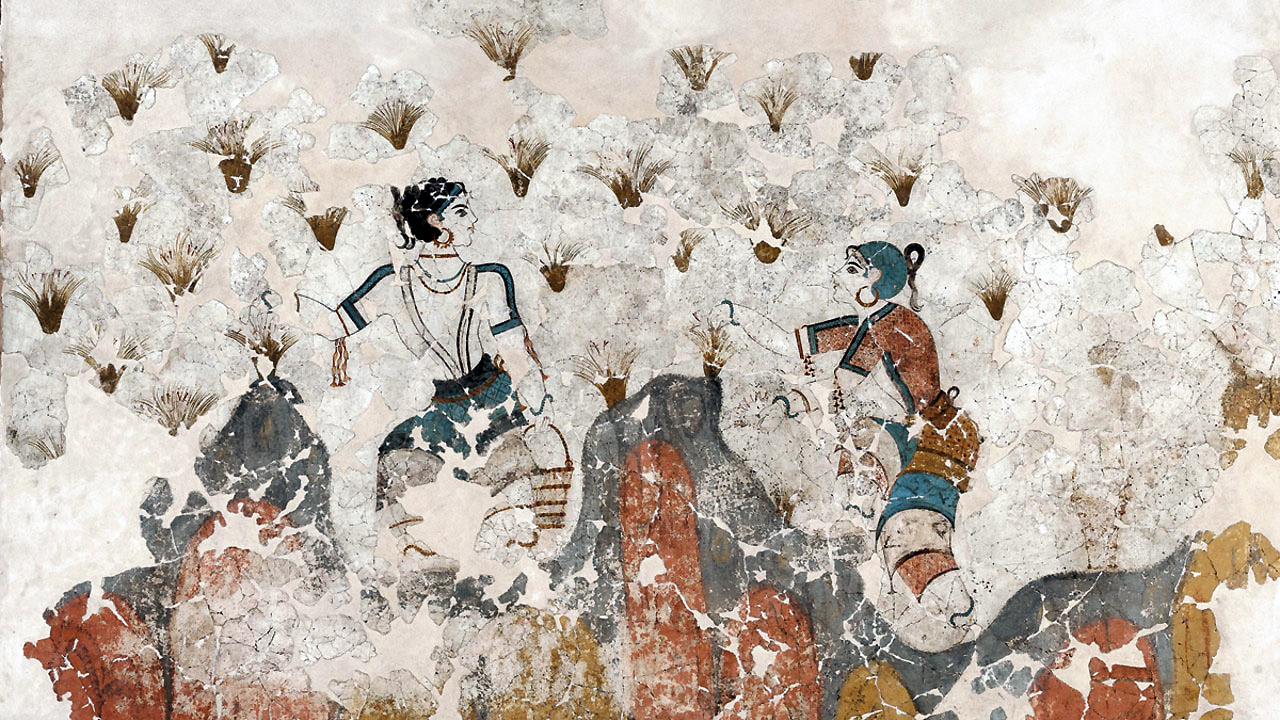
Fresco of Crocus gatherers, from the House of Xeste three, 1st floor, eastern wall, Minoan, Akrotiri, Thera, c. 1600 B.C.E.
Can we come across a person like Eritha in the finely dressed, powerful looking women represented in wall painting and sculpture? If so, information technology is yet again an interesting female-privileging in Aegean art. Looking across the Linear B record of priests and priestesses, we find more priests than priestesses.
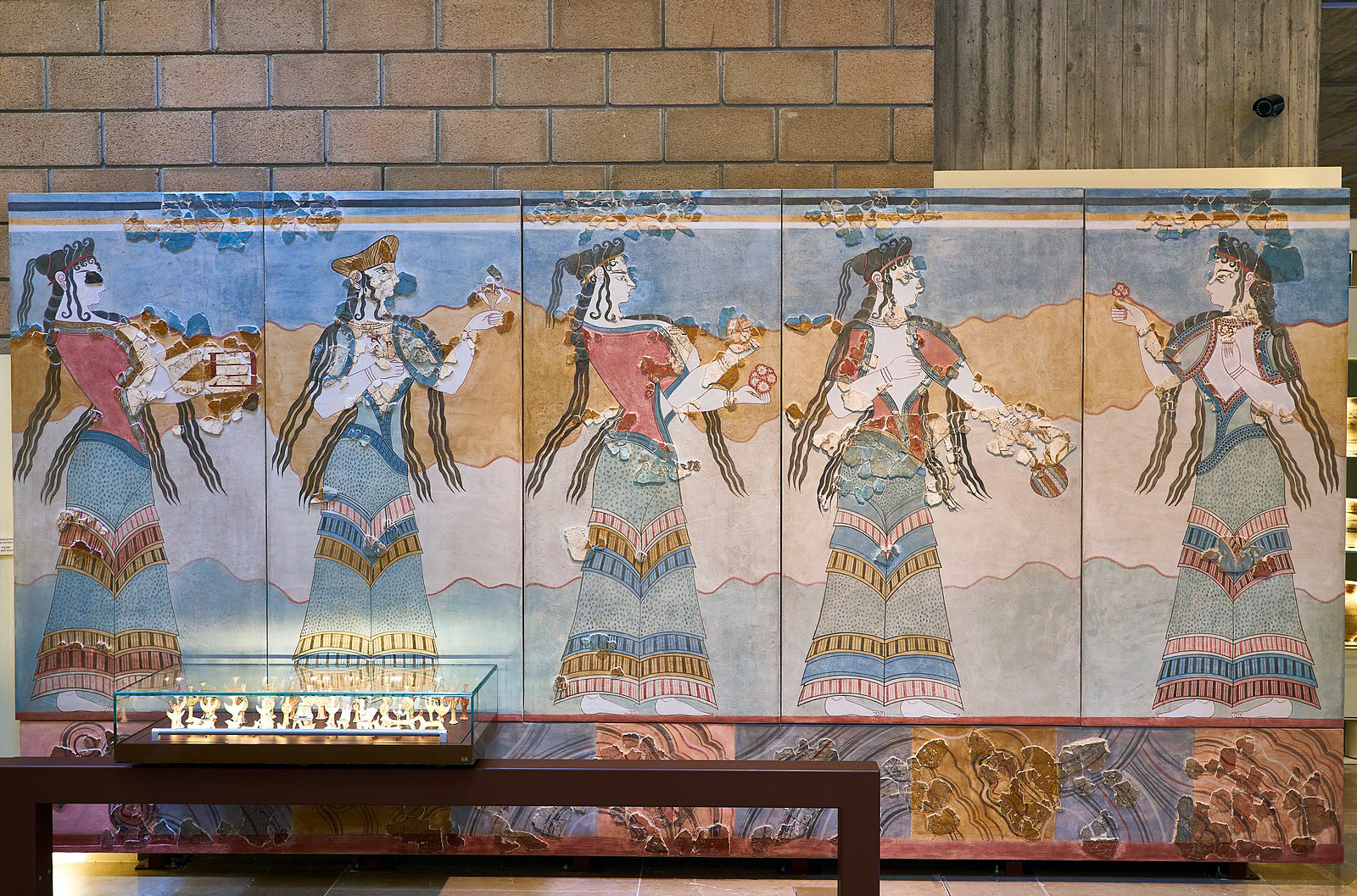
Reconstruction of a wall-painting from Thebes, with five women dressed in elaborate outfits, walking in a procession and property offerings, c. 14th–13th c. B.C.E., Mycenaean, Palace of Thebes (Archaeological Museum of Thebes, Boeotia, Greece; photo: George Eastward. Koronaios, CC0)
If the women we run across in Aegean art are such priestesses, their role in representation would appear more significant than their male counterparts. This circumstance is fabricated all the more interesting because, as it has been oft noted, in that location are no images of rulers in Aegean Art—i of a handful of things that distinguishes it from contemporary Egyptian and Well-nigh Eastern visual culture where rulers are oft displayed in a diverseness of media.
Non-elites
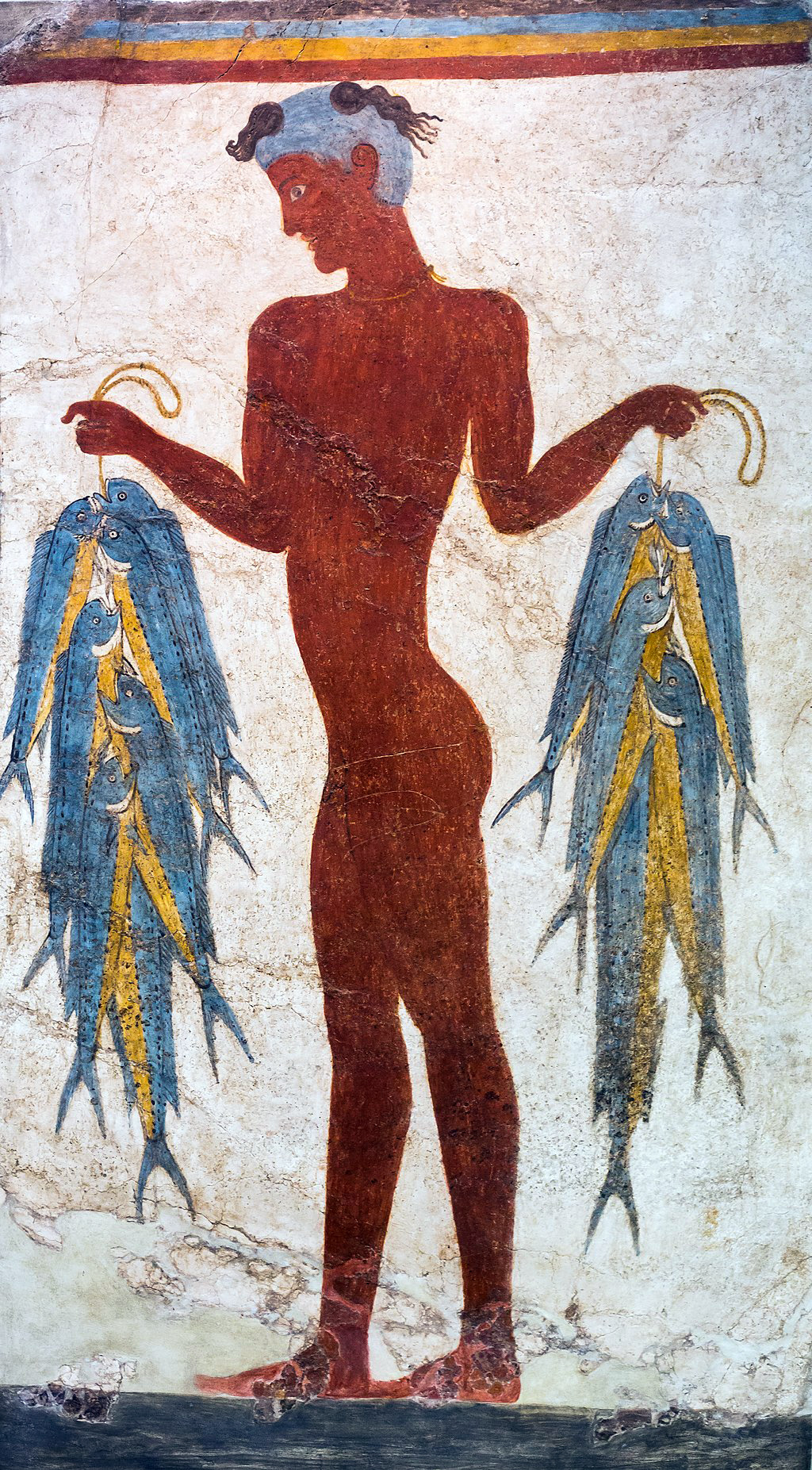
Fisherman fresco, c. 17th century B.C.E., Minoan, Room 5 fo the West House, Akrotiri, Thera (National Archaeological Museum, Athens; photograph:
But what about non-elite women—and men? So much of the written report of the Minoans and Mycenaeans is focused on palaces and elite merchandise in luxury appurtenances. Very lilliputian has focused on the people producing these luxury appurtenances and supporting palatial centers. Indeed, Aegean art rarely includes these non-elites, but they were primal to the material culture of the Aegean that nosotros written report. Among their rare appearances, we tin can include the image of a young fisherman among the paintings at Thera.
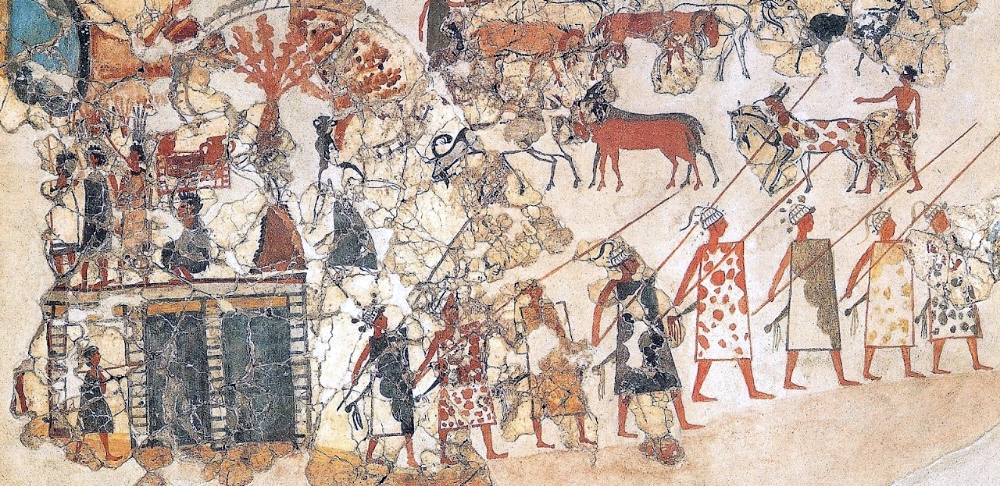
The correct office of this fresco shows shepherds with their herds, c. 1600 B.C.E., Minoan, West House, Akrotiri, Thera
And, in a miniature painting from the same site, shepherds are seen tending their flock in the mountains—a distinctly non-aristocracy activeness. Shepherding, along with over two dozen other non-elite professions, are mentioned on the Linear B tablets. These are:
- sheep husbandry,
- wool harvesting,
- wool spinning and weaving,
- perfumed oil production,
- flax harvesting,
- spinning and linen production,
- cooking,
- building construction,
- bronze working,
- leather working,
- soldiering,
- olive oil and wine production,
- agricultural work,
- chariot repair,
- lapidary work,
- for seals and jewelry,
- golden,
- argent,
- ivory working,
- blue glass working,
- scribal piece of work,
- flax spinning,
- weaving,
- garment making,
- pottery production,
- net making and ship building.
This list describes worlds of practice, teaching, fine skills, technical knowhow, virtuoso talent, project management, supply chain oversight, and plain old hard work—all performed past the non-elite. And, for many of these professions, we can today nonetheless treasure the fruits of their labor, such every bit the minutely detailed and stunning power of the golden and rock blended sculpture of the Minoan bull's head rhyton or the Palaikastro Kouros.
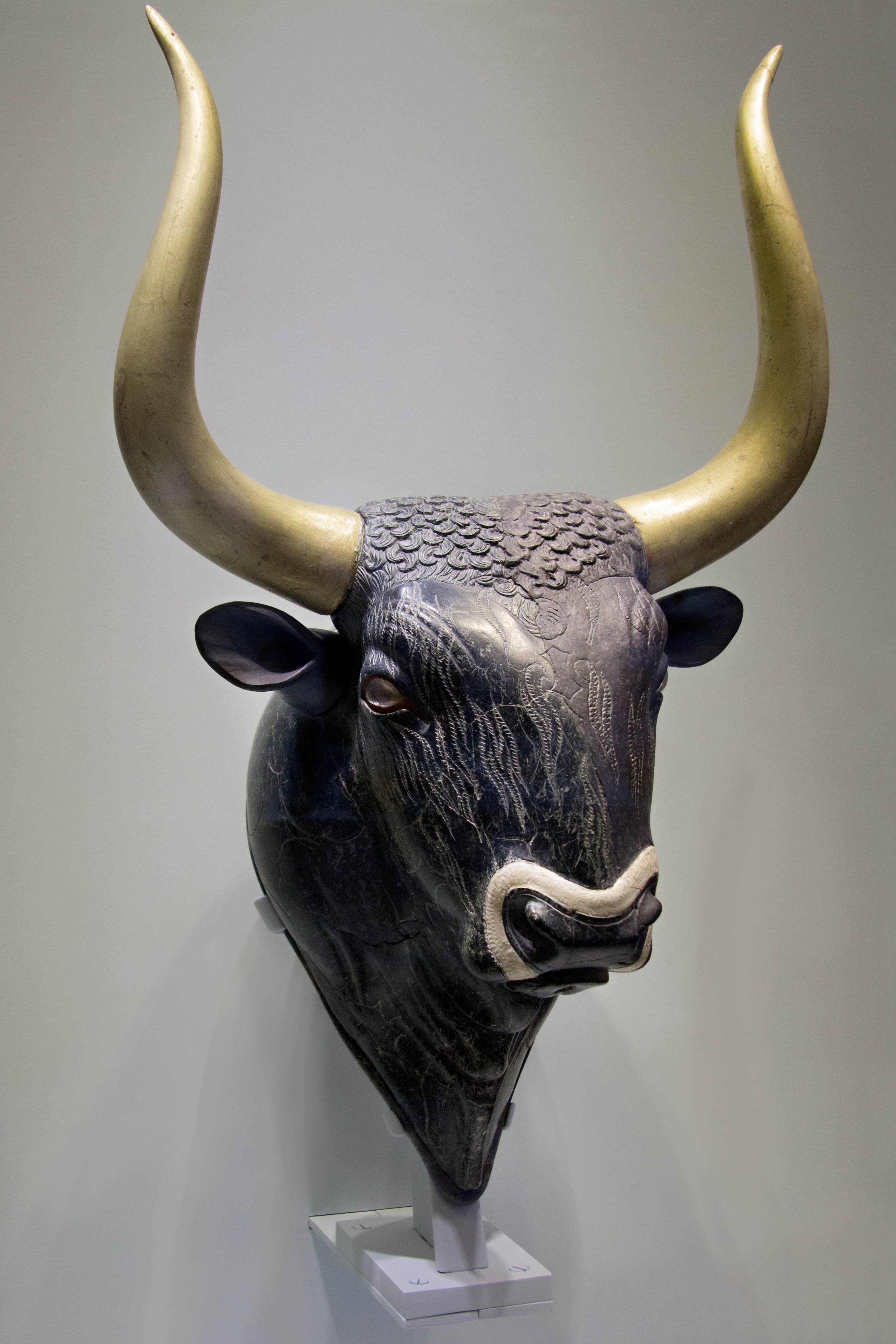
Bull'south head rhyton from the palace at Knossos, c. 1550–1500 B.C.Due east., Minoan, blackness steatite, jasper, and mother-of-pearl, 26 cm loftier (Archaeological Museum of Heraklion, photograph: Zde, CC Past-SA iv.0)
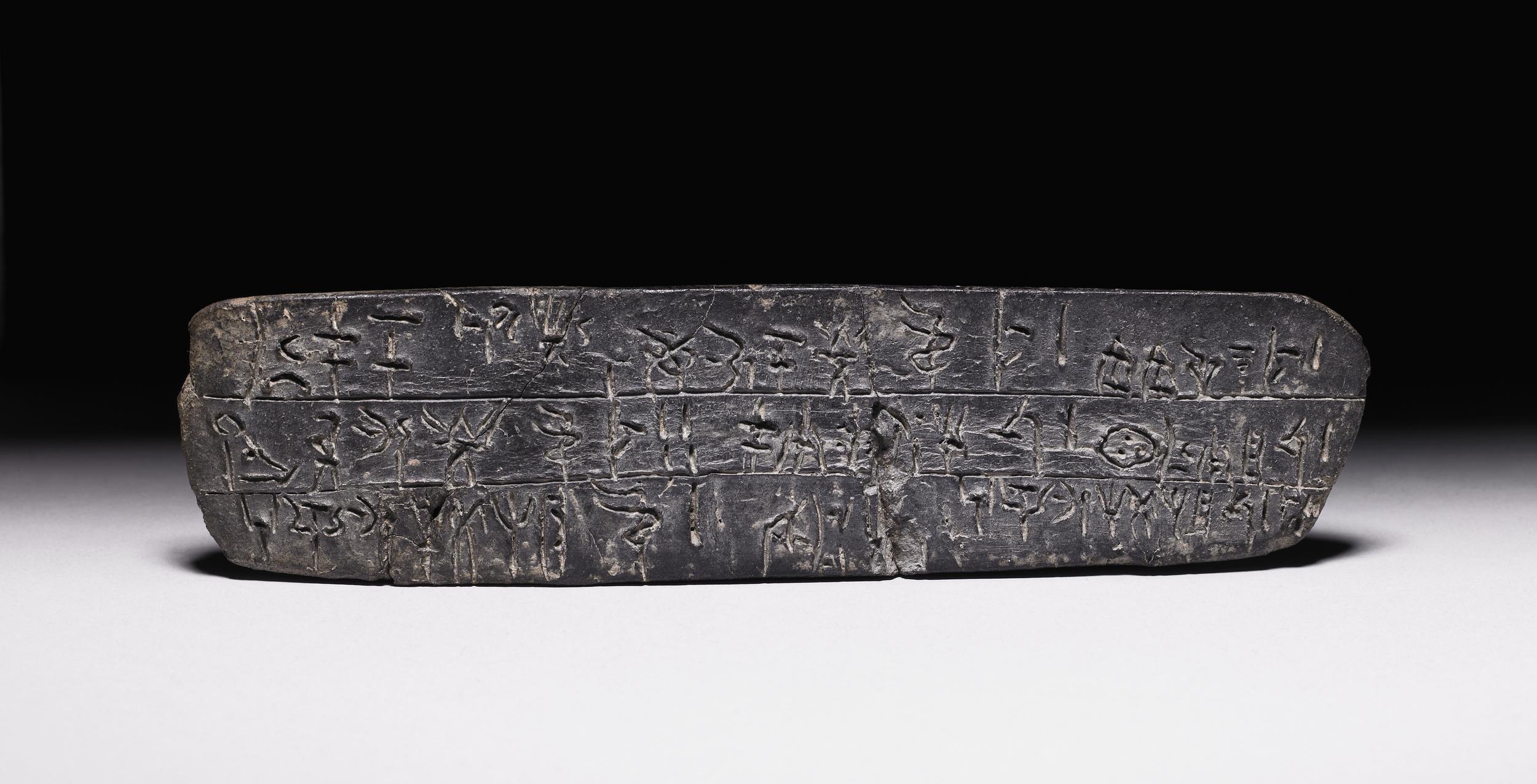
Tablet with Linear B script (describes oil offered to deities and religious officials), c. 1375 B.C.E., Late Minoan IIIA, Knossos, Crete (© Trustees of the British Museum)
Linear B tablets, so often mined for information virtually authoritative control, ancient economical models, ability hierarchies, and wealth distribution, are likewise a rich resource for information virtually the everyday people who lived and worked, worshipped and loved, struggled and died in the Aegean Statuary Age. To meet these people in individual item, unfortunately, is very difficult nonetheless some glimpses are possible, as the frescoes at Thera demonstrate. At the Minoan palace at Phaistos, we accept evidence of children's and perhaps women's (their mothers?) finger and handprints on the insides and bases of pots. To be sure, to work in the pottery workshops of a palace site like Phaistos was to participate in the product of naught less than one of the virtually important export products of the Aegean: painted pottery.
Scout videos and read essays about non-elites
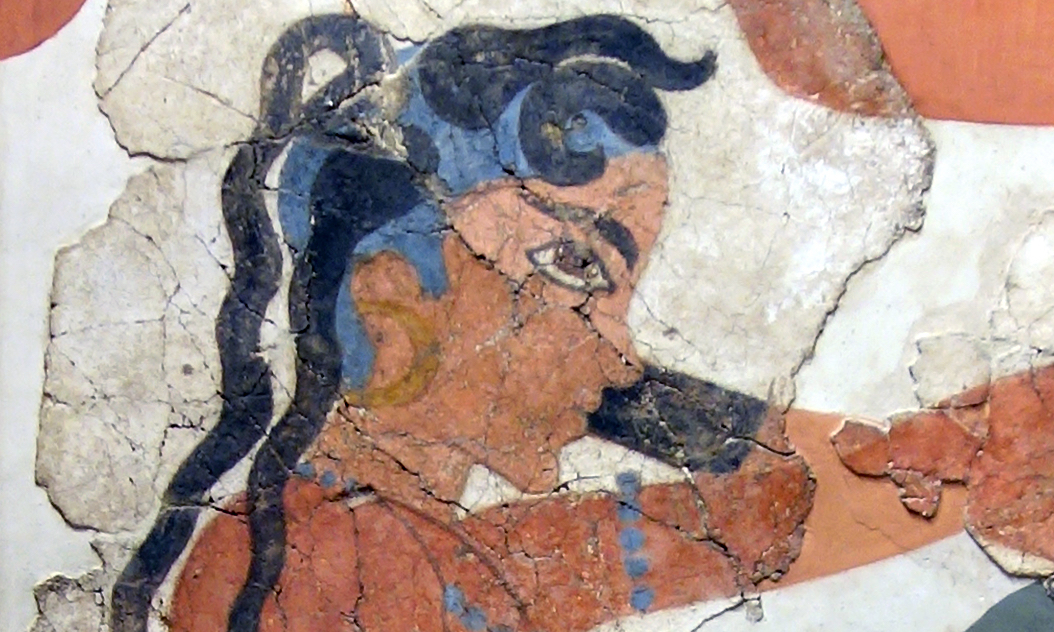
Akrotiri, Thera murals: These murals show a range of subjects, including women, shepherds, boxers, and more than.
Read Now
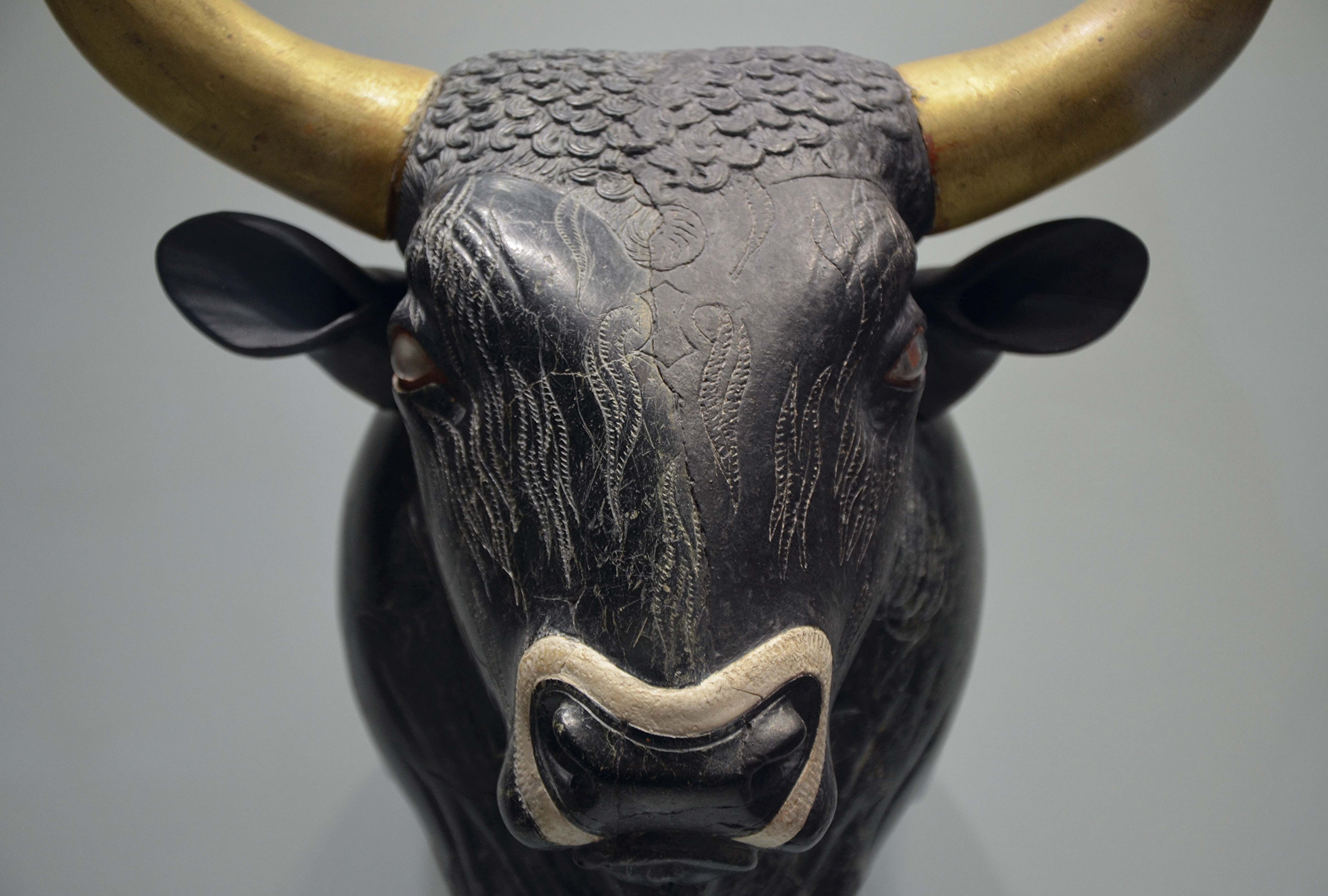
Balderdash's Head Rhyton: This was carved from a single block of blackness steatite—and shows incredible skill.
Read At present
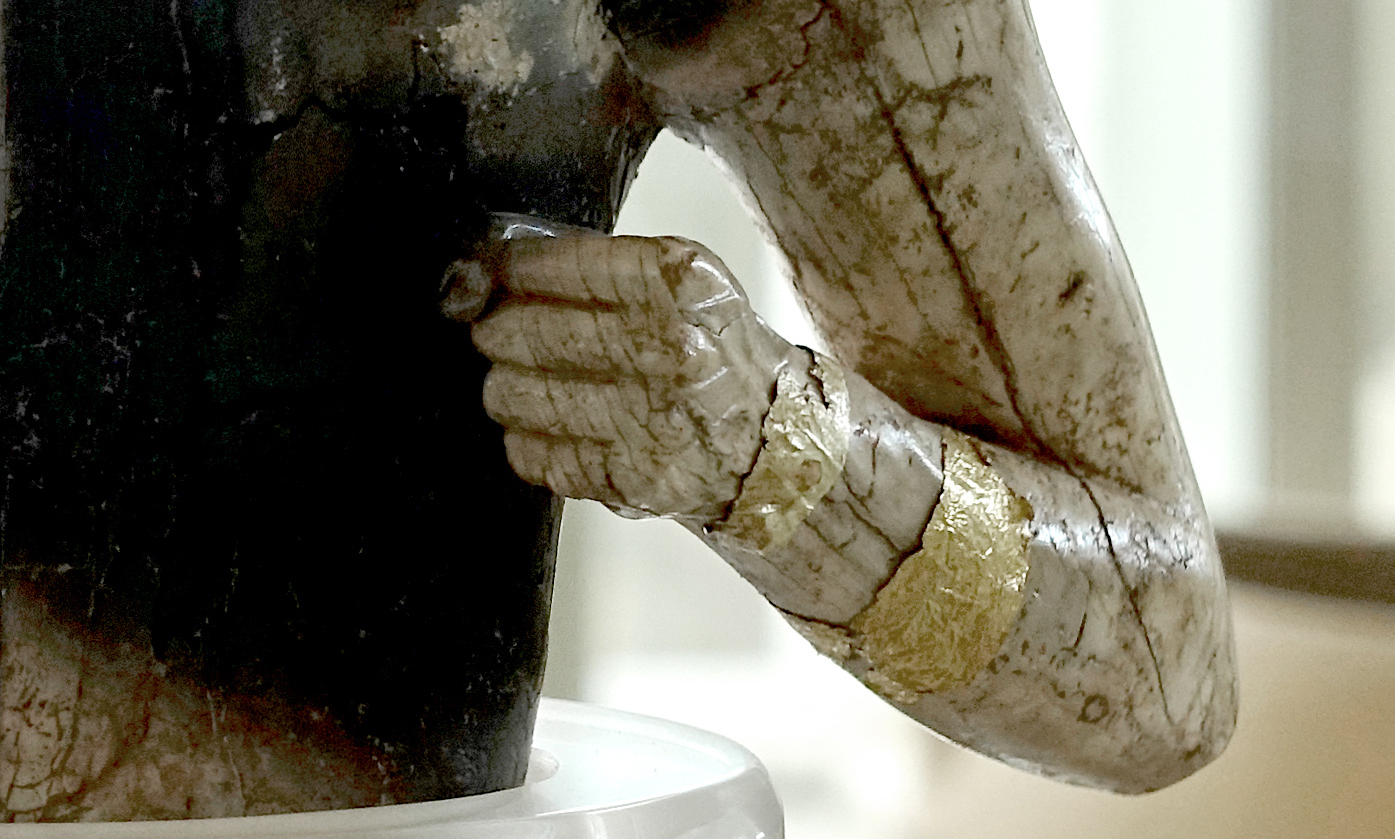
Statuette of a Male Figure (The Palaikastro Kouros): What does this figure tell united states about non-elites?
Read Now
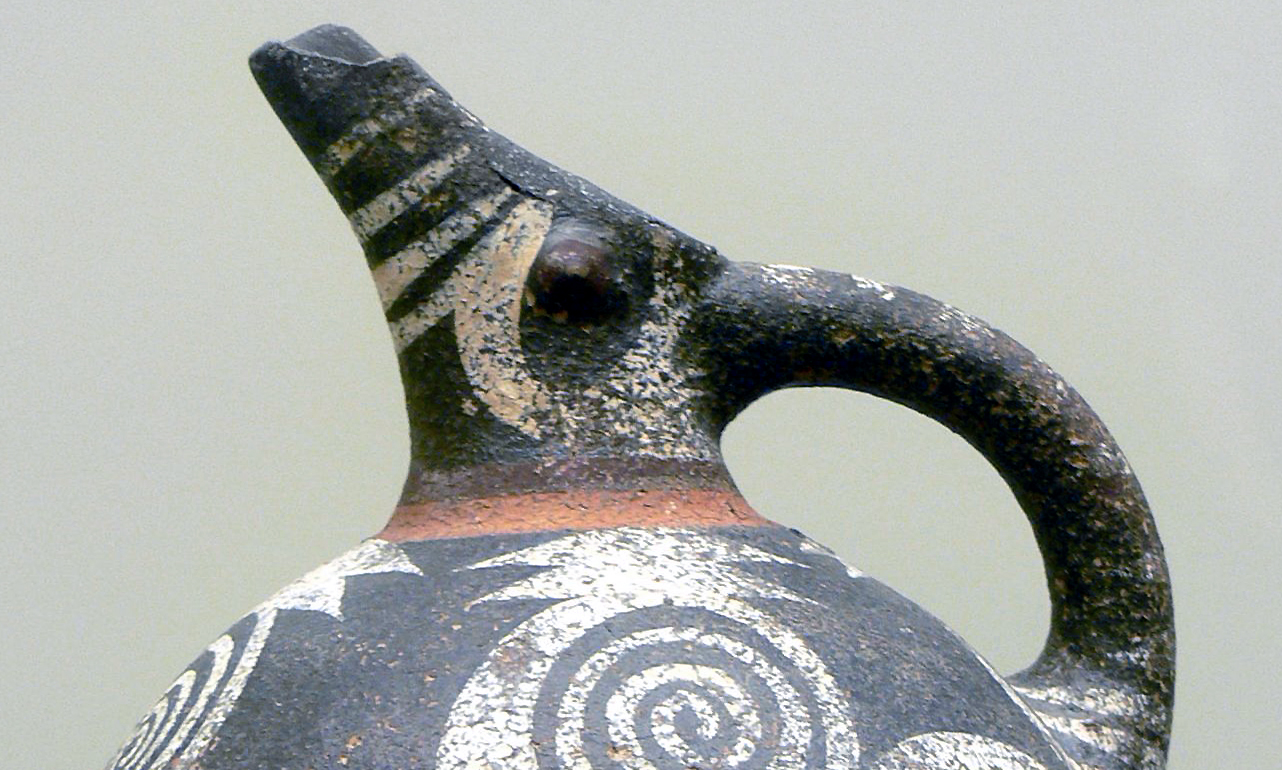
Kamares Ware Jug: Consign pots like this ane tell us nigh networks of exchange and pottery workshops.
Read Now
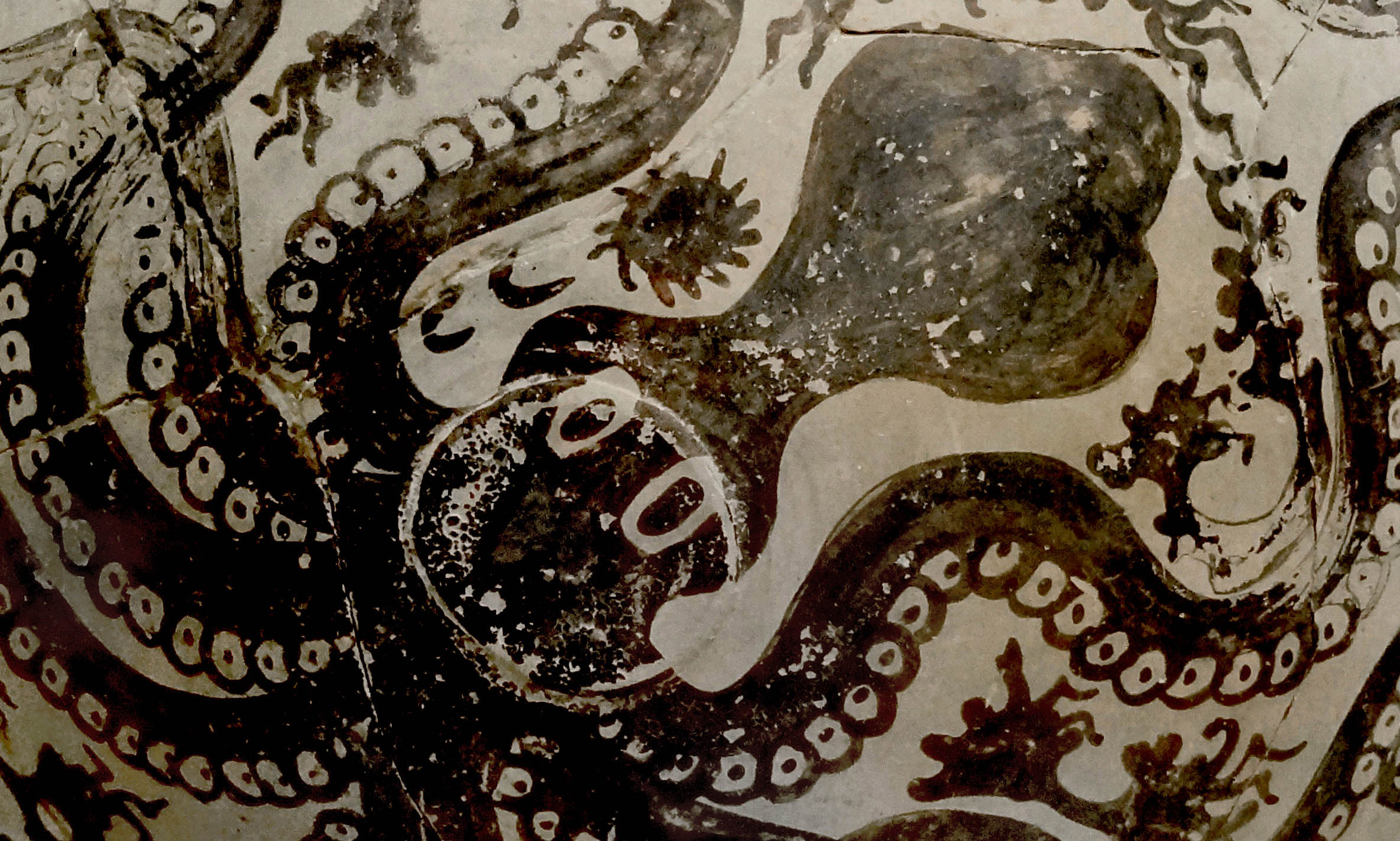
Octopus vase: What can this vase tell us almost non-elites and networks of exchange?
Read Now
/5 Completed
Palaces as popular ritual spaces
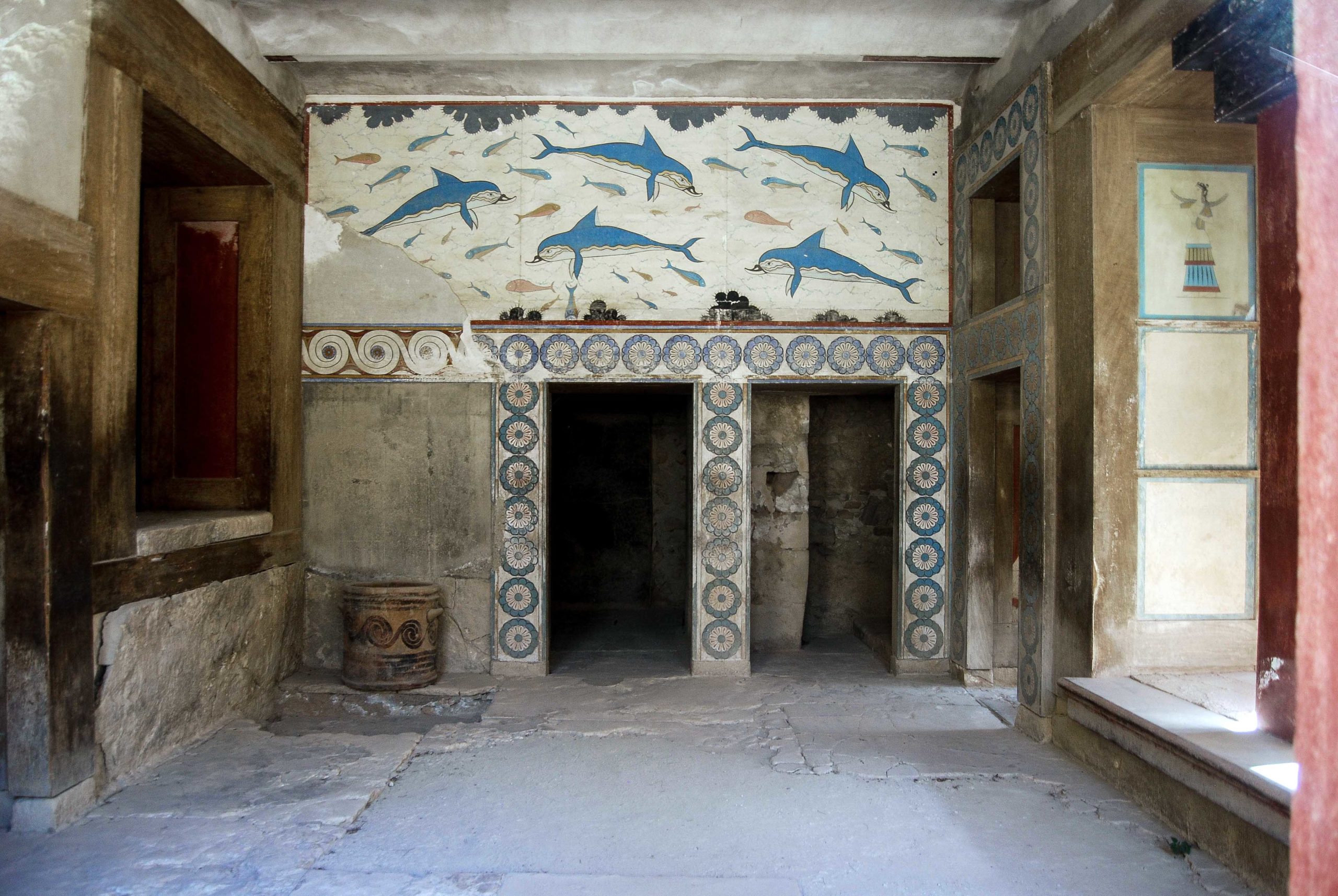
"Queen'southward megaron," East Wing, Knossos, Minoan (photo: Andy Montgomery, CC By-SA 2.0)
For proficient reason, the palace centers of the Aegean take been the focus of much archaeological investigation and written report: thrones, richly painted rooms, dramatic façades, elaborate paving, labyrinthine passages, and even indoor plumbing created what must take been comfy and exclusive spaces for the ruling theocratic elite to live and piece of work. However, other parts of these structures were congenital to be used by the non-elite, including spaces for ritual operation to be observed and perhaps joined, to demark ordinary Minoans and Mycenaeans to their gods and leaders. Past shifting focus away from throne rooms to civic spaces, these people are revealed.
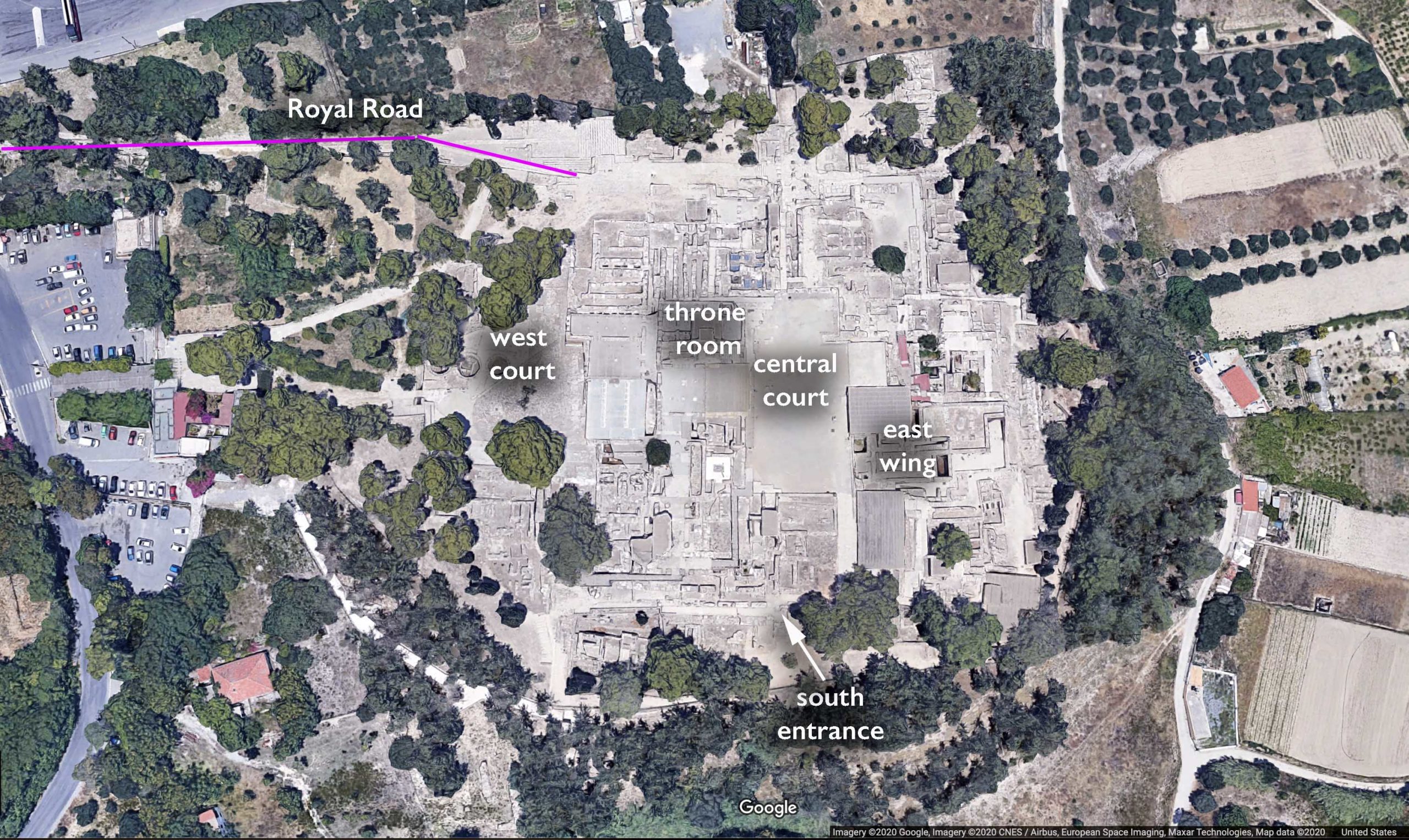
Aeriform view of Knossos (underlying map © Google)
The most vivid example of an architectural space fabricated for a viewing public is what is referred to equally the theatral area or west court of the Minoan Palaces on Crete. These are carefully paved plazas with adjacent broad steps for audience seating and are one of the nearly distinctive details of Minoan palaces. Smaller, paved courts with adjacent seating are also found in not-palatial sites. At Knossos, information technology is estimated that some 500 people could exist accommodated in the largest of the courts. This is not just an audience of the aristocracy, the not-elite and the workers of the palace also sat hither.
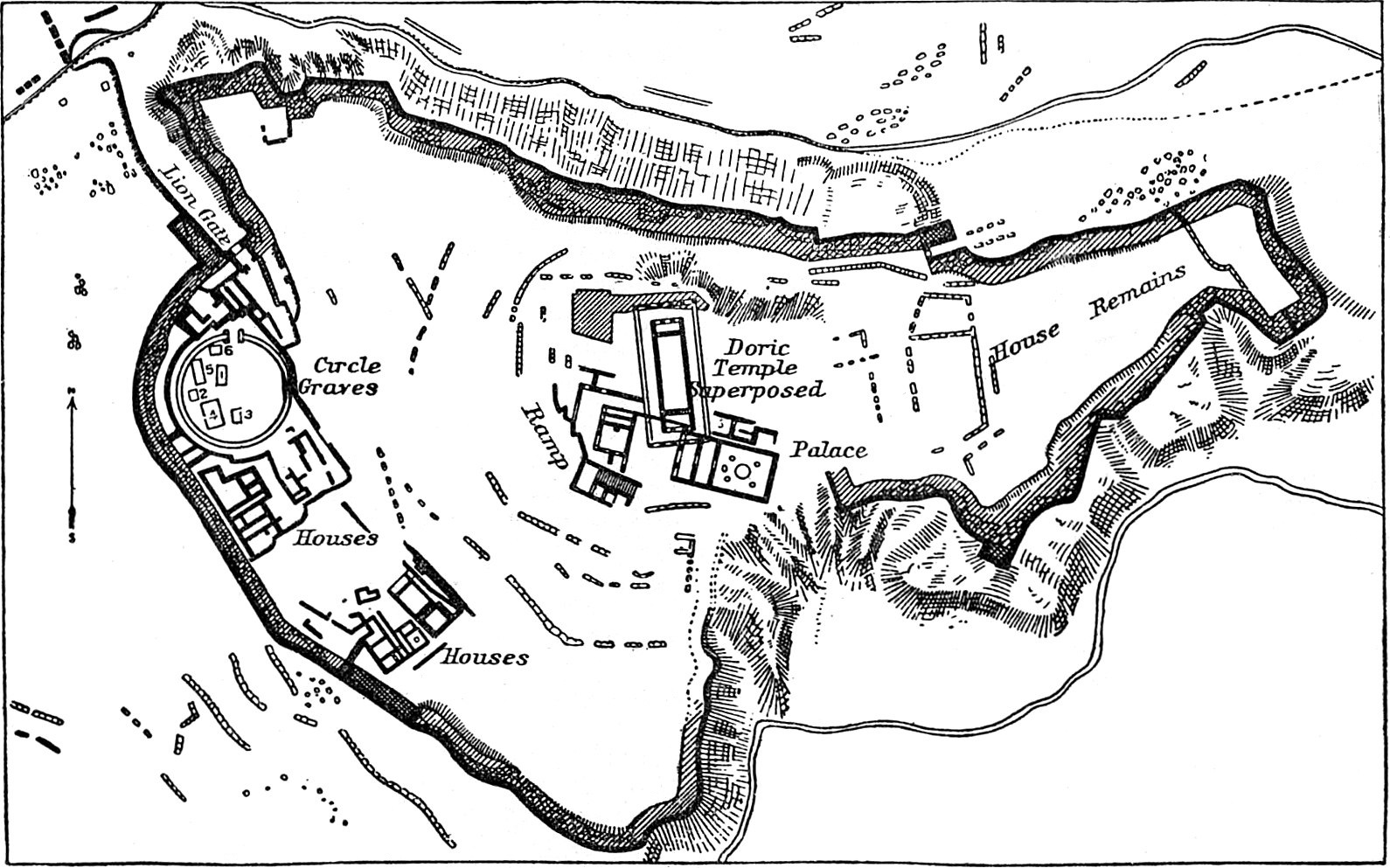
Plan of the Citadel of Mycenae
Turning to the Mycenaean mainland of Greece, interestingly, central sites, frequently citadels, lacked such open courts and, in general, had much smaller open up spaces. All the same, these sites were nearly always situated on high plateaus, to afford a commanding view down, and so the population of the region would expect up to them.
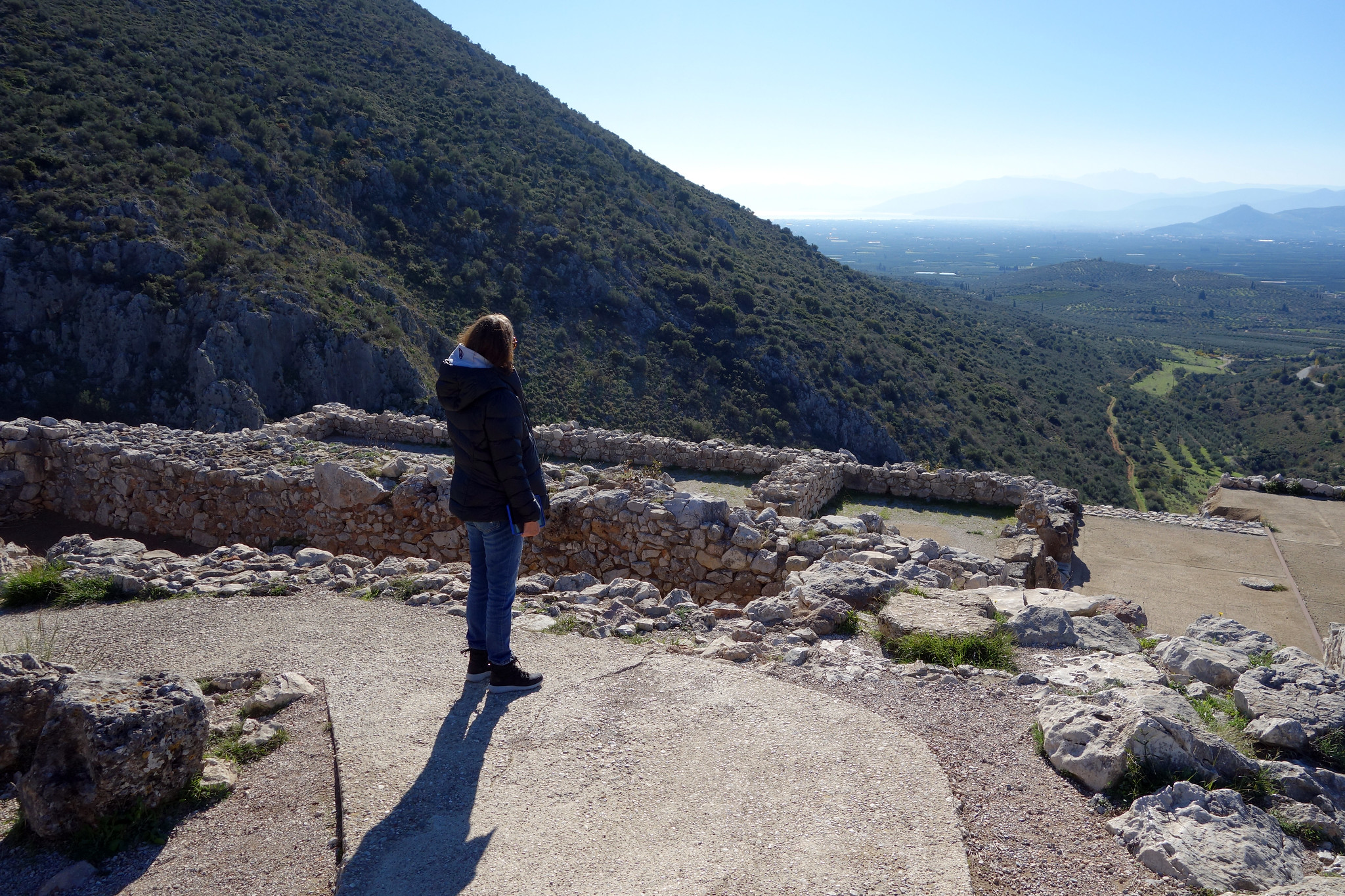
Looking past the archaeological remains of the "Palace" to the sea, Mycenae, Greece, c. 1600–1100 B.C.Due east.
Non unlike the way in which the spires of medieval pilgrimage churches were erected to great heights in order to office every bit focal points of prayer and inspiration for the surrounding population and travelers, the Mycenaean palaces' commanding positions may imply a large, observant congregation of local people.
Interestingly, i of the near mutual painted motifs constitute in Mycenaean palaces is that of a single file procession of elites, finely dressed men and women (such equally the one shown before from Thebes), holding offerings. Processions, like any performance, only have ability through witness. Possibly such painted processions mimic private elite performances held within the palaces simply, given the limited interior space for groups, not many would take been able to notice. However, the siting of the Mycenaean citadels themselves would accept fabricated a procession leading upwards to them visible to many. Archaeologists accept discovered a complex network of roads, including massive bridges over valleys, between Mycenaean sites, including Mycenae. Homer, who mentions Mycenae frequently, in human relationship to its selfish king Agamemnon, describes information technology every bit wide wayed (pregnant wide, well-paved), and busy with people and commerce.
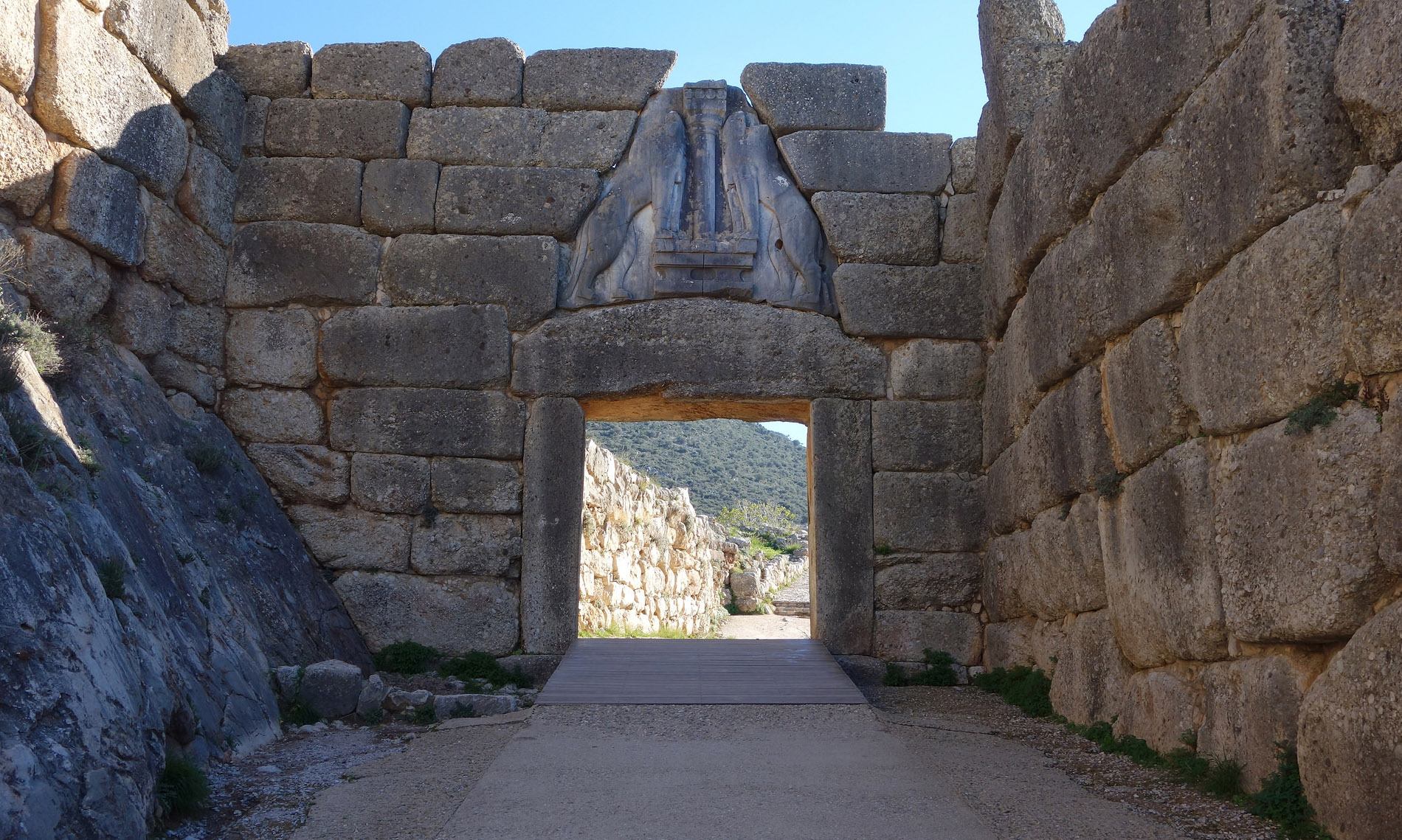
Lion Gate, Mycenae, c. 1300–1250 B.C.E., limestone, relief console, 9′ 6″ high
These roads might be seen as a dissimilar sort of public space, non large and square as at the Minoan palaces, simply long and broad. Leading to the palace centers within the loftier-walled citadels, they would have been the perfect venue for the thousands of workers and support personnel of the Mycenaean kings, to gather and wonder at the ability of their labour, value of their craft, and purpose of their work.
Read an essay and picket a video nigh palaces as pop ritual spaces
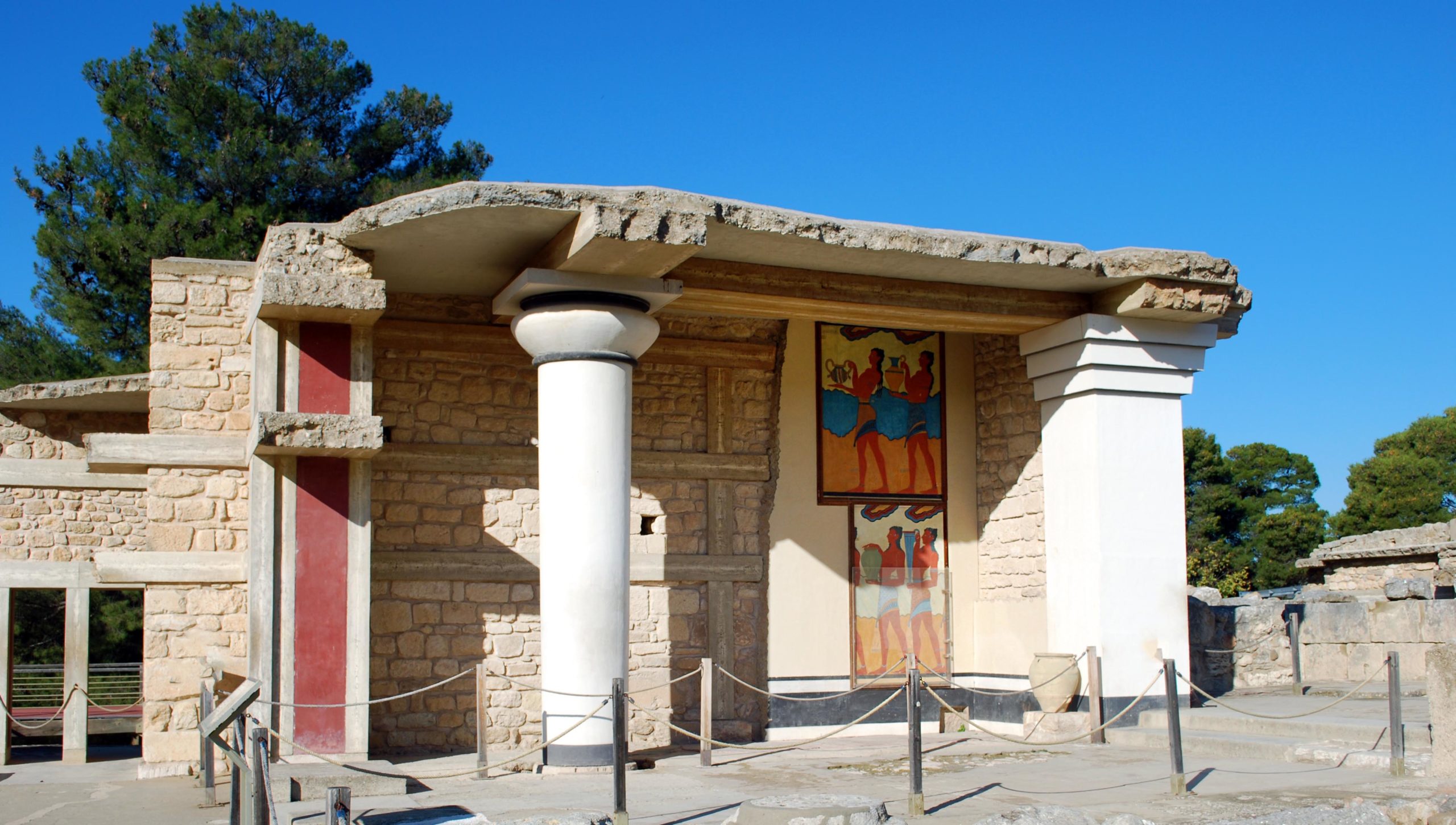
Knossos: A palace that can tell us virtually elite and non-elite life on Crete.
Read At present
![[caption id="attachment_51043" align="aligncenter" width="870"] Looking past the "Palace" to the sea, Mycenae, Greece, c. 1600-1100 B.C.E.[/caption] The ancient citadel (fortified city) at Mycenae (in southern Greece) is located on top of an isolated hill, and provides truly spectacular views of the surrounding area, making it an ideal location for defensive purposes. Mycenaean culture dominated southern Greece, but is perhaps best known for the site of Mycenae itself, which includes this hilltop citadel (which included a palace), and nearby, different forms of tombs and other structures. Mycenaean culture firmly establishes itself in the late Bronze Age, specifically, around 1600 B.C.E. [caption id="attachment_27867" align="aligncenter" width="1002"] The](https://smarthistory.org/wp-content/uploads/2020/08/12043943365_72ae28bb78_k.jpg)
The "Palace" and Grave Circle A: Consider the means that "palaces" and other structures at the citadel of Mycenae can still reveal stories about the peoples living in and around it.
Read Now
/2 Completed
Looking at the Statuary Age cultures of the Cycladic islands, Crete and the Greek mainland—with or without Homer—information technology is impossible not to wonder about the important people who held power and influence. Every bit of import, however, is understanding the lives and contributions of those who were non so important, for instance, women and the non-aristocracy, the subjects of this chapter. It is only with a view to the full spectrum of human being experience of the past that we tin can begin to write a history that means something to all of us.
Notes:
[i] PY Eb 416 and PY Ep 704 are ii Linear B tablets. They employ a detail citation fashion to designate the specific ones. PY designates a tablet'due south origin in Pylos, and more than 1,000 tablets accept been found there. The abbreviations similar Eb, Ep, etc. designate different series to which the tablets belong.
[2] PY Tn 316
Fundamental questions to guide your reading
How does the art and architecture of the Cycladic islands, Crete, and the Greek mainland demonstrate that their visual traditions influenced each other?
What can the fine art and architecture of the Cycladic islands, Crete, and the Greek tell u.s.a. well-nigh women and non-elites?
How does focusing on different aspects of elite architectural centers, Minoan palaces, and Mycenaean citadels reveal them as places of participatory ritual?
Jump downwardly to Terms to Know
chesneytistonedide47.blogspot.com
Source: https://smarthistory.org/reframing-art-history/reframing-aegean-art/

0 Response to "Aegean Art Time Period Time Period of Aegean Art"
Post a Comment